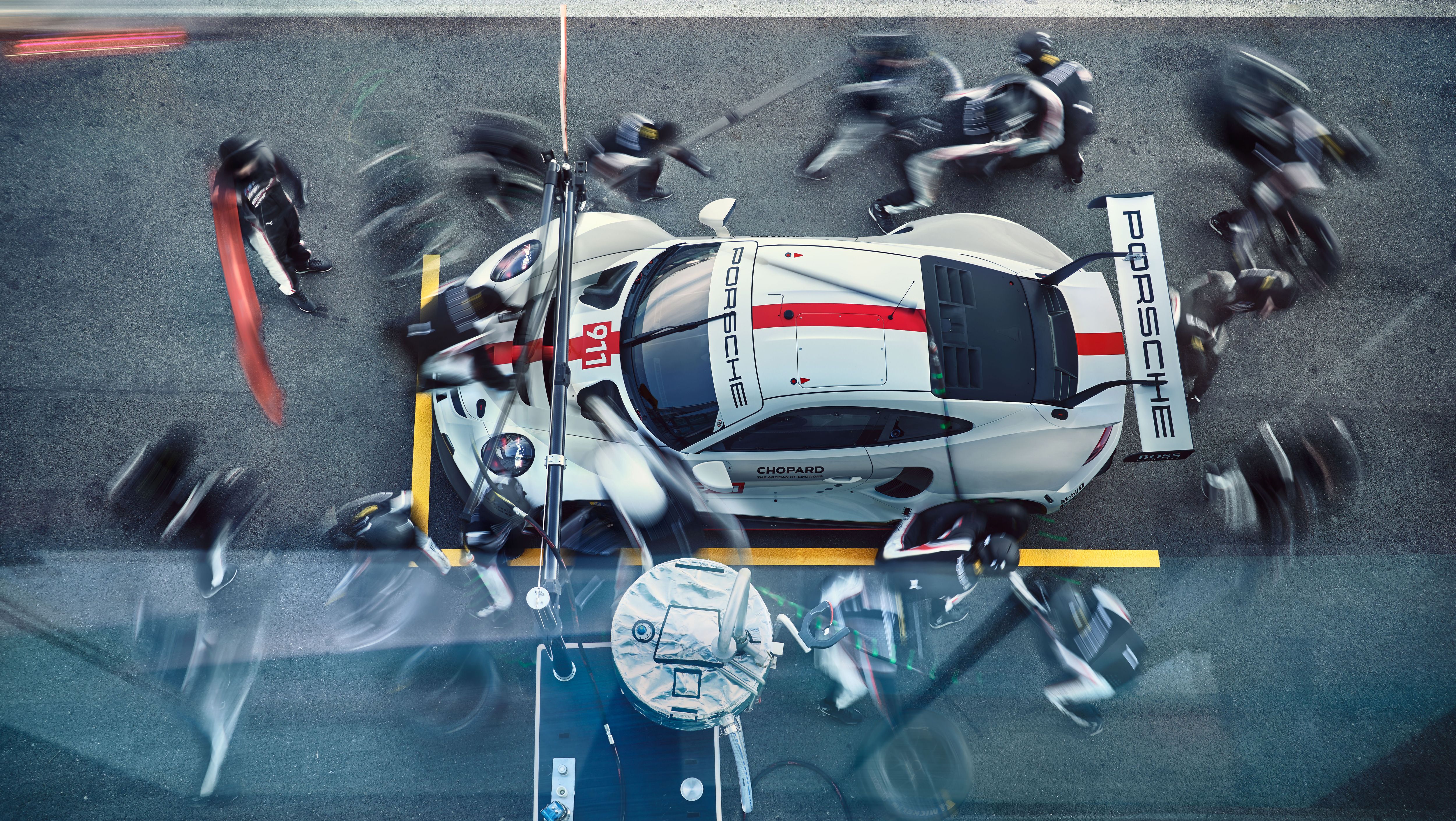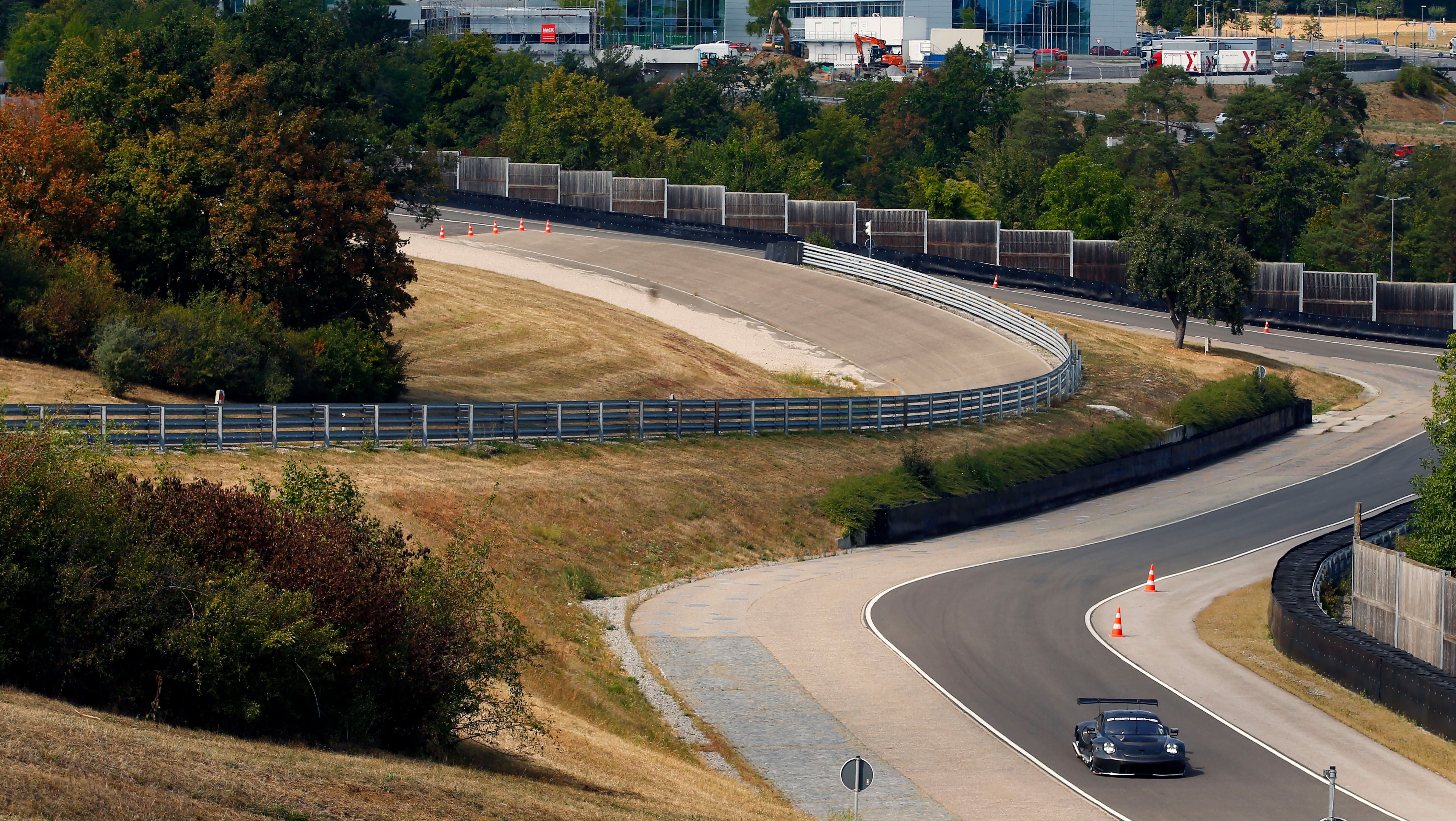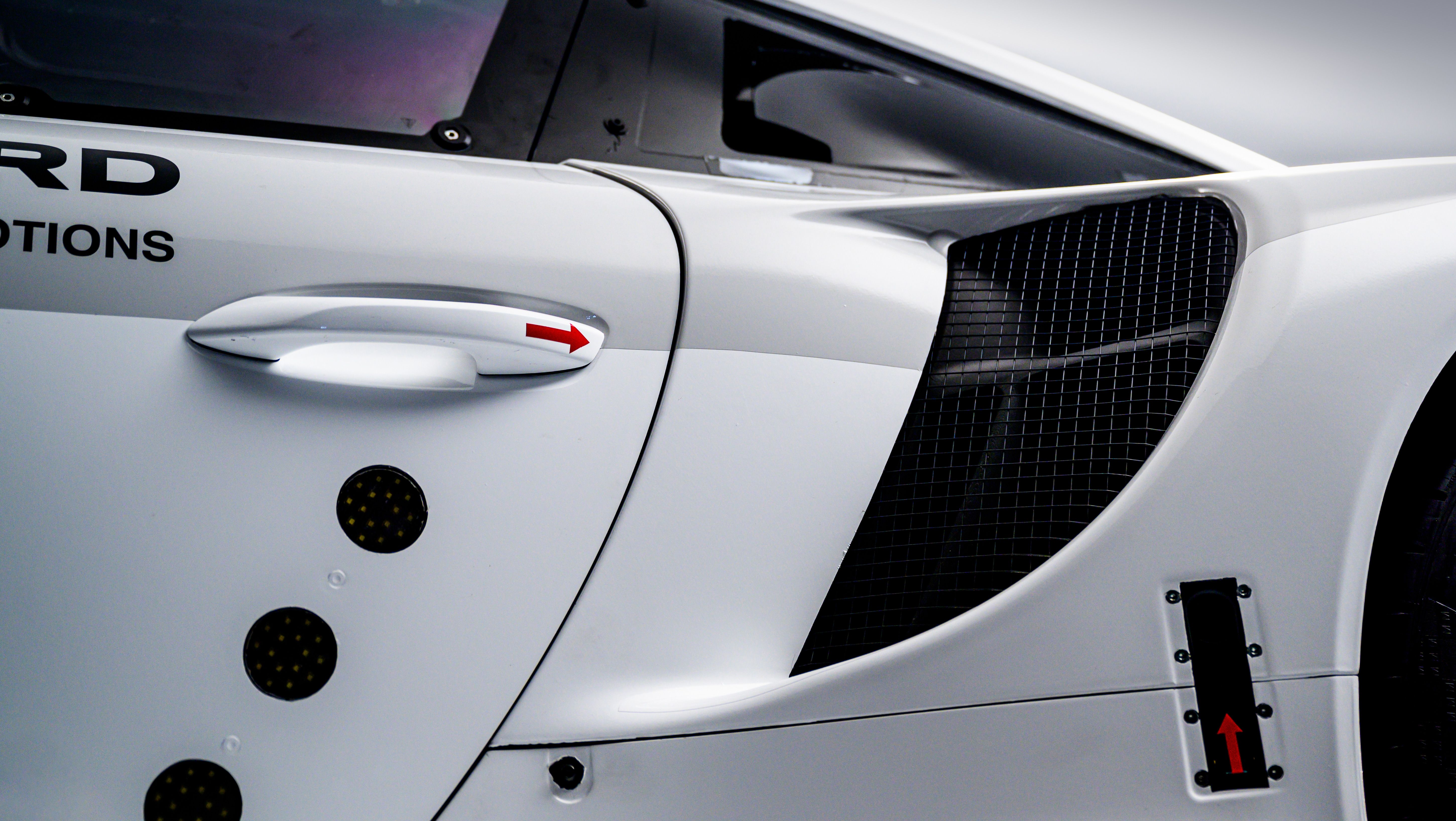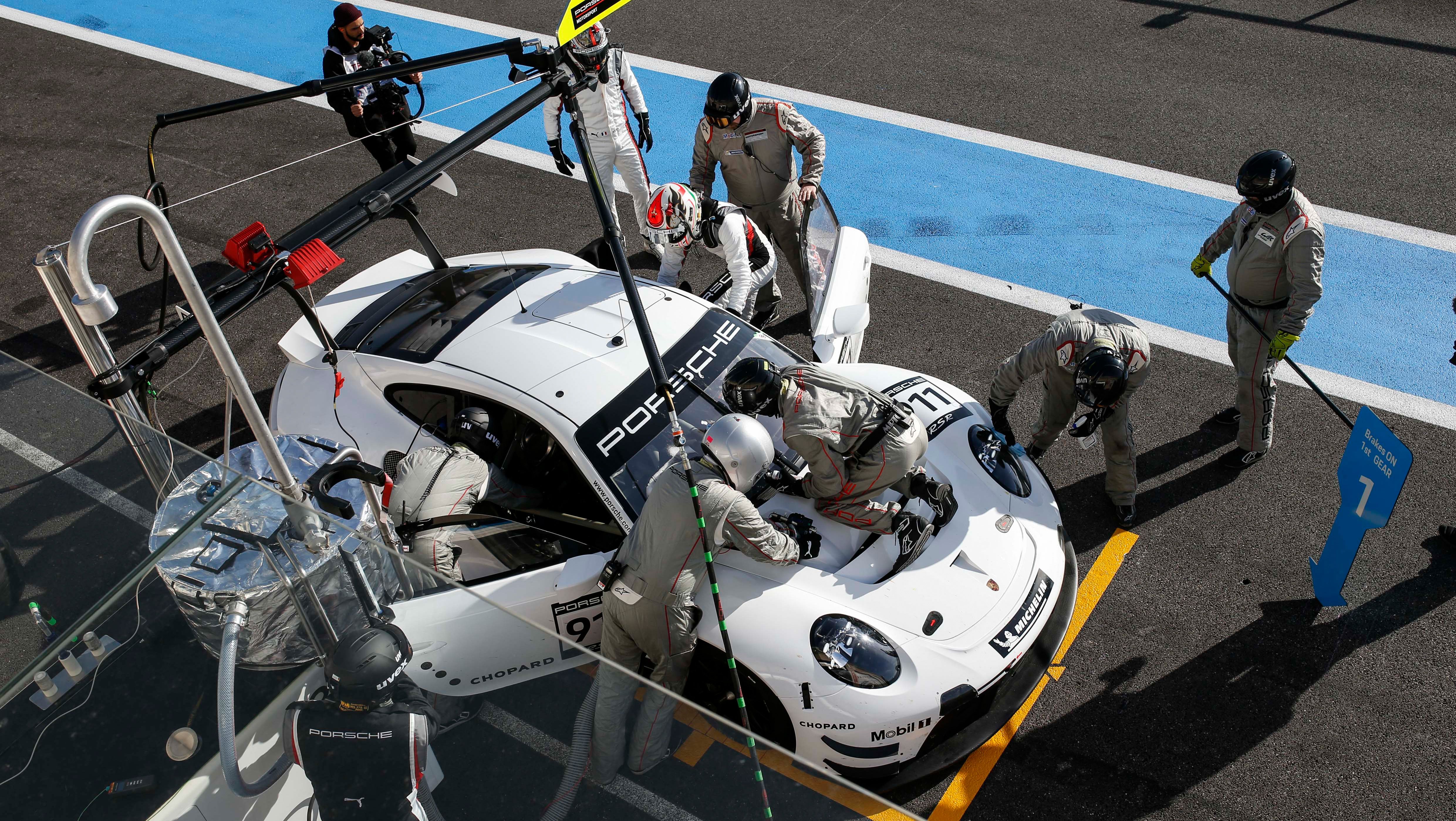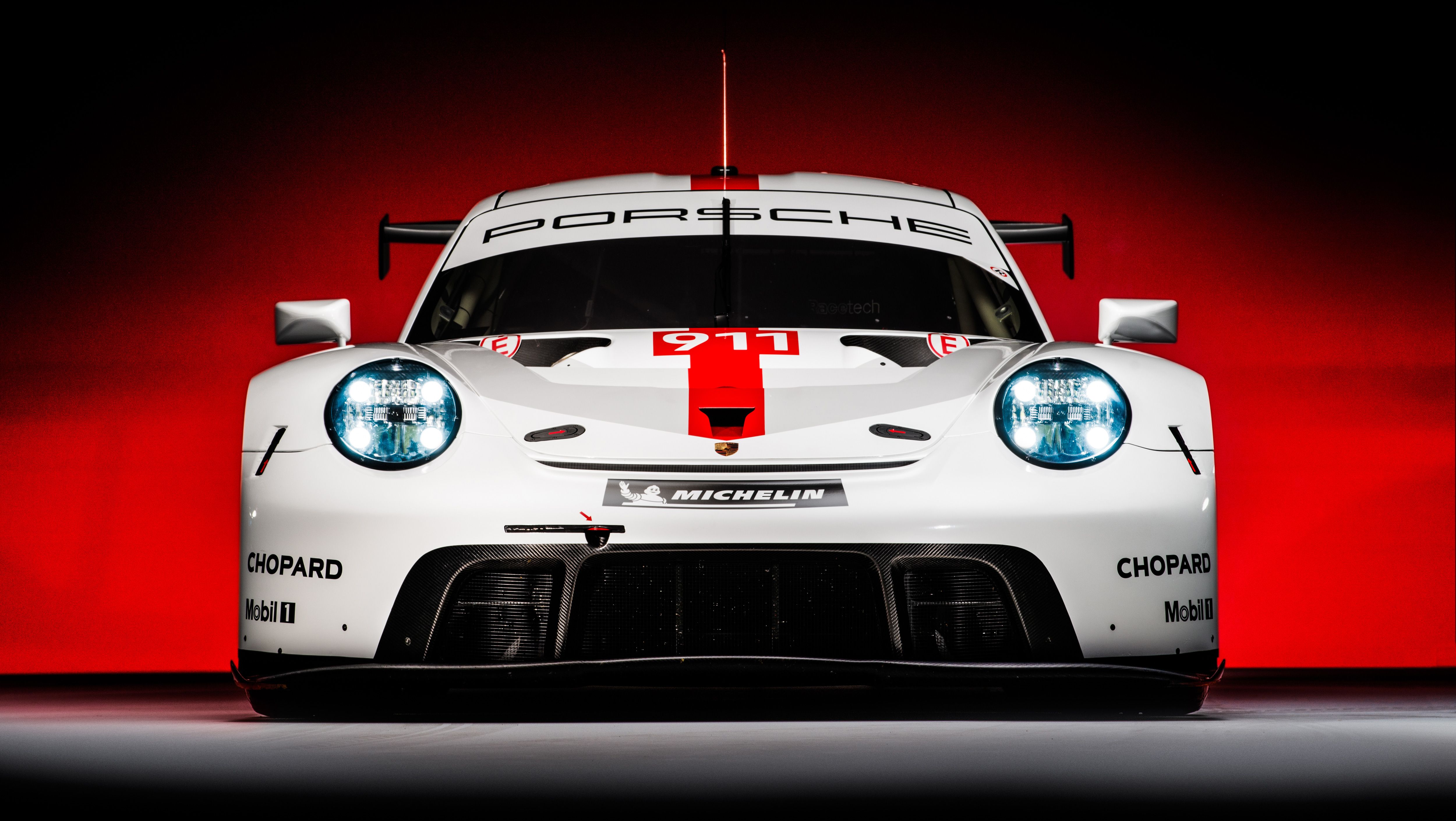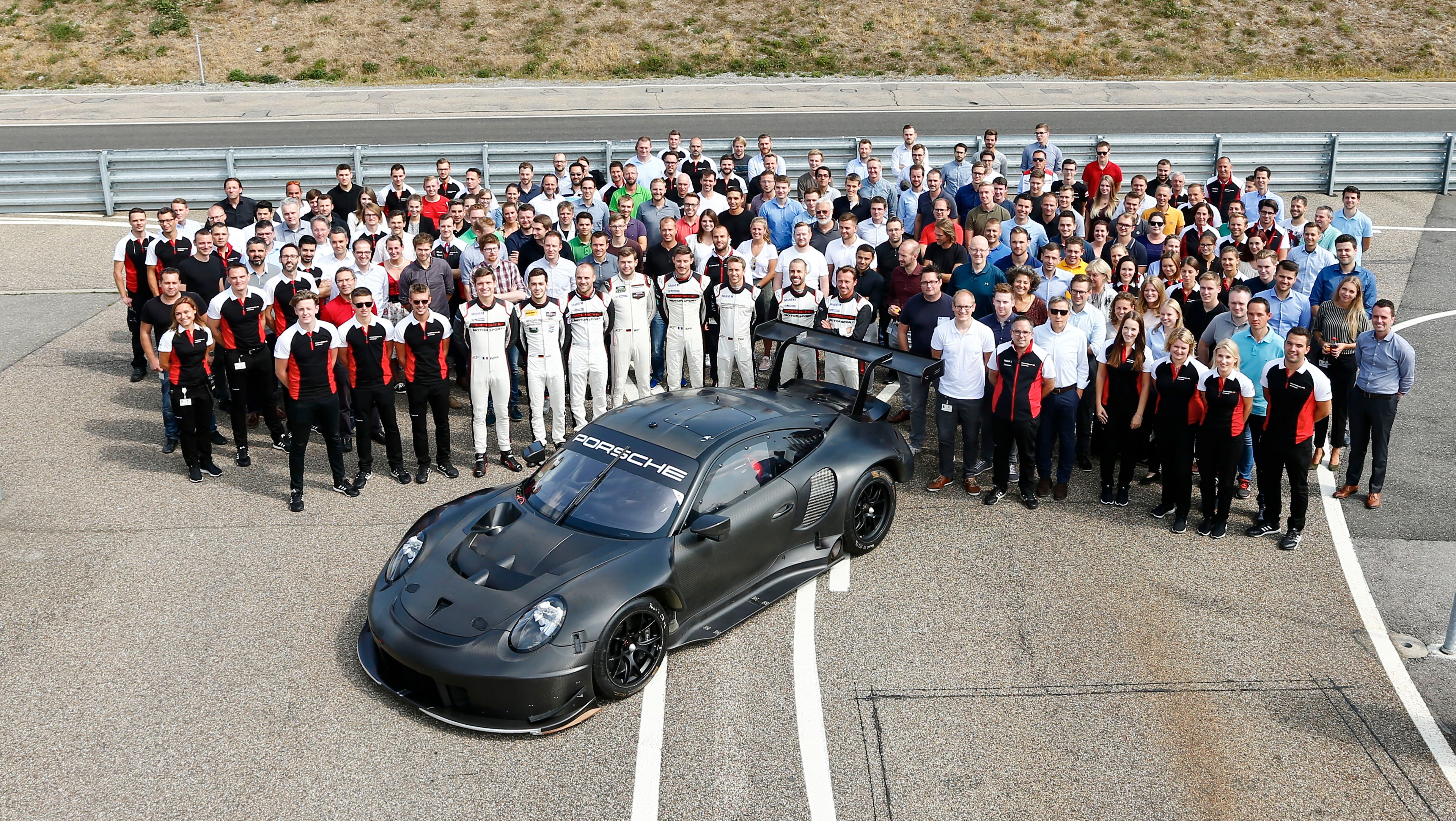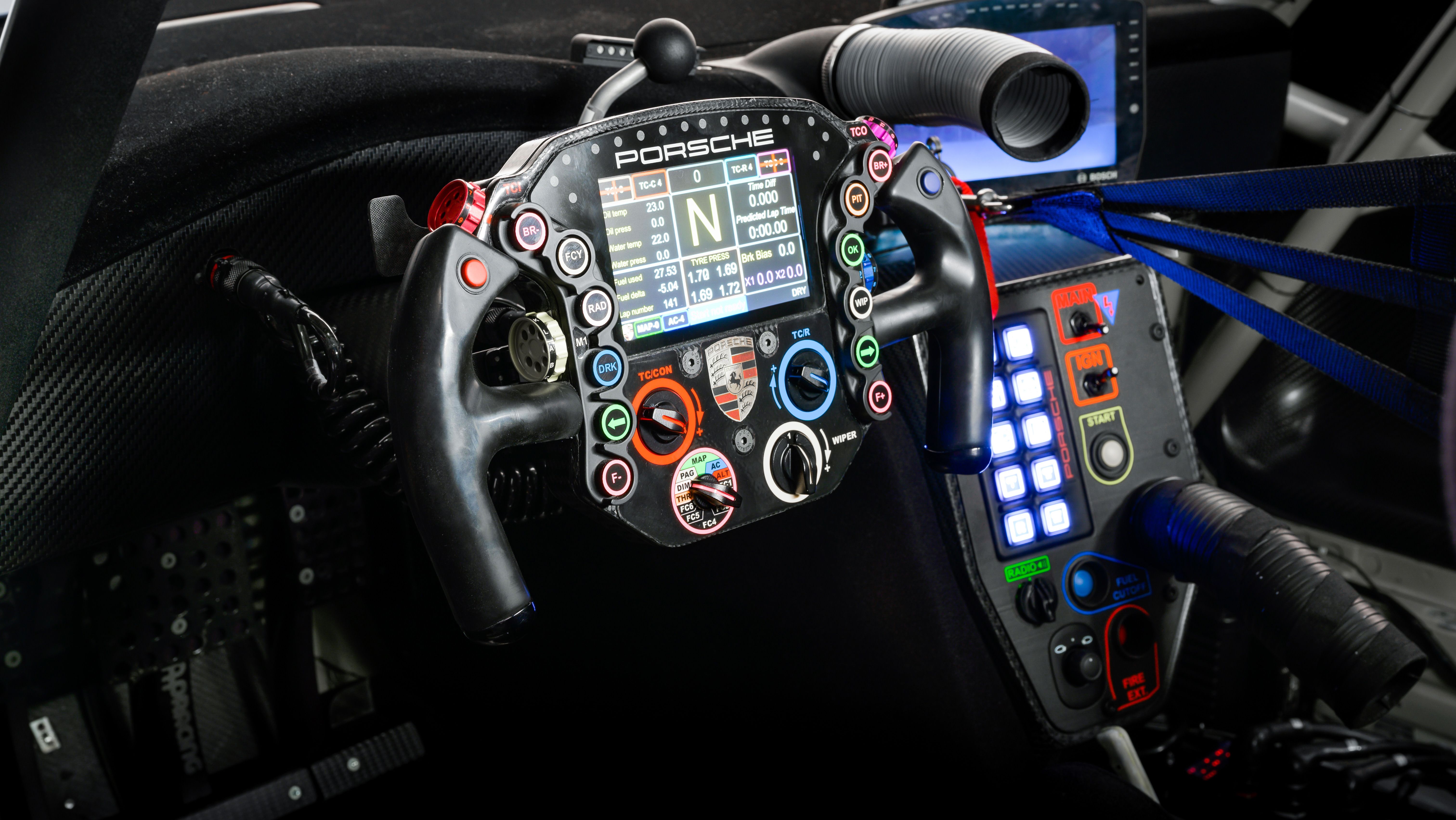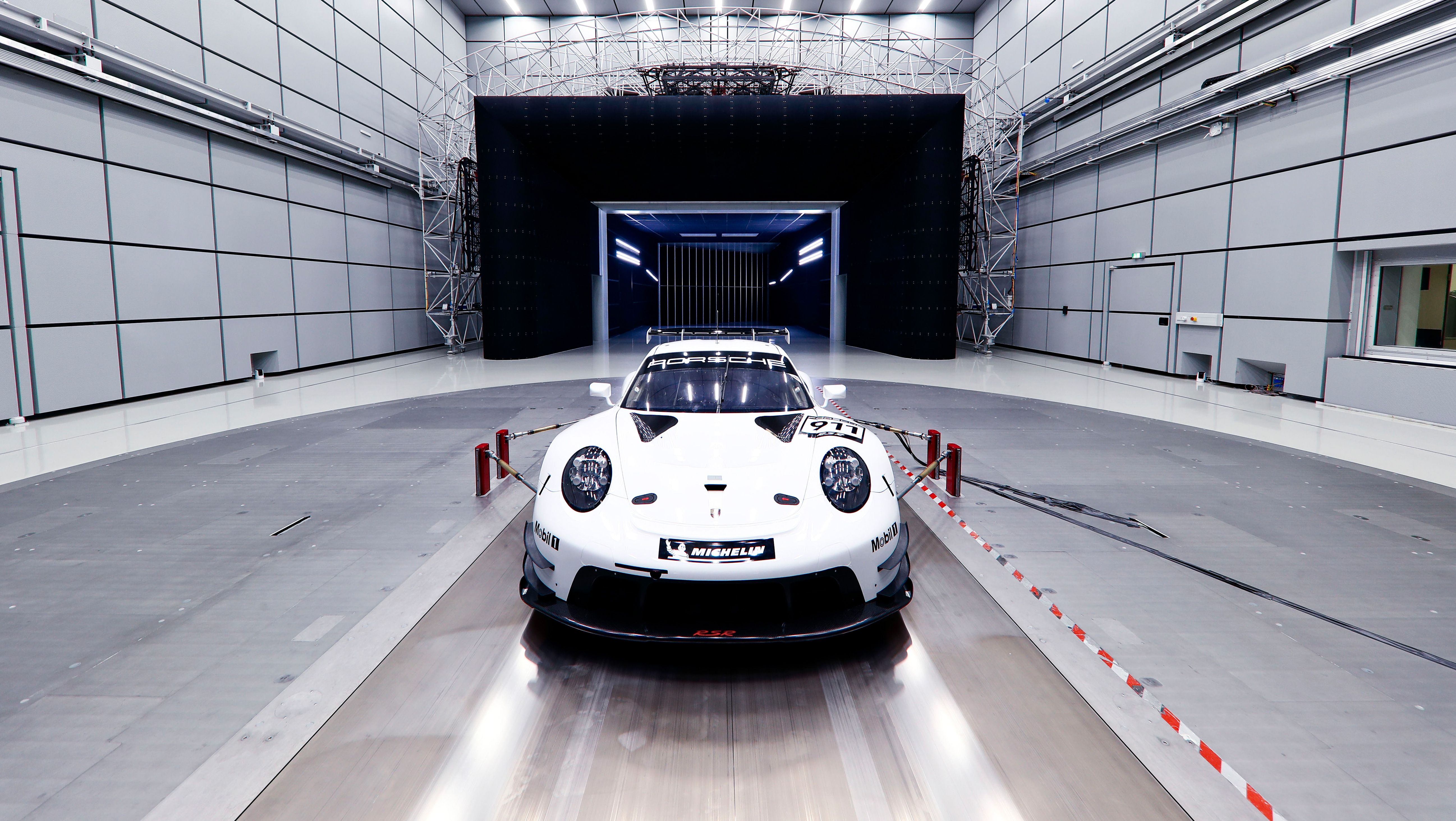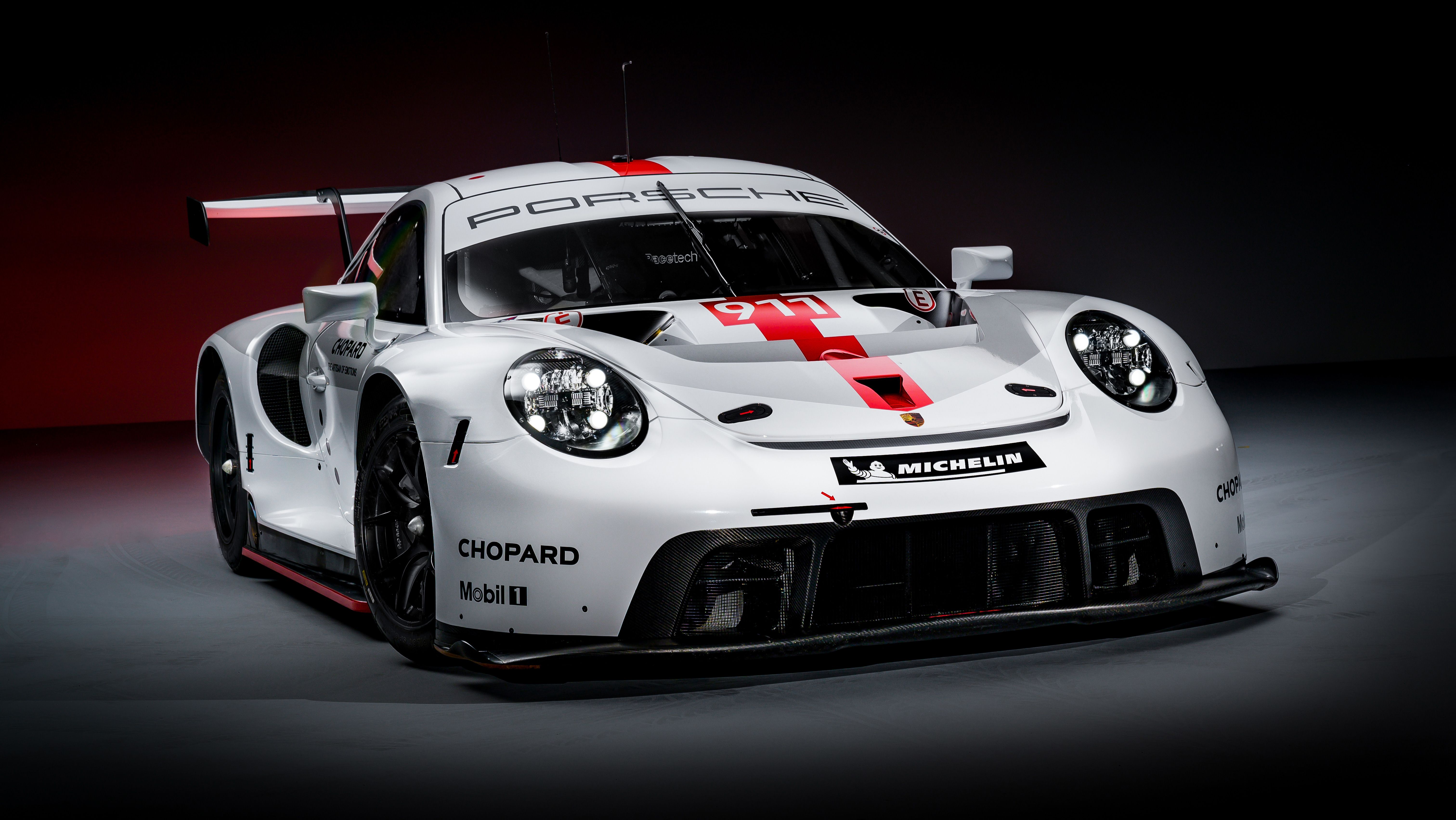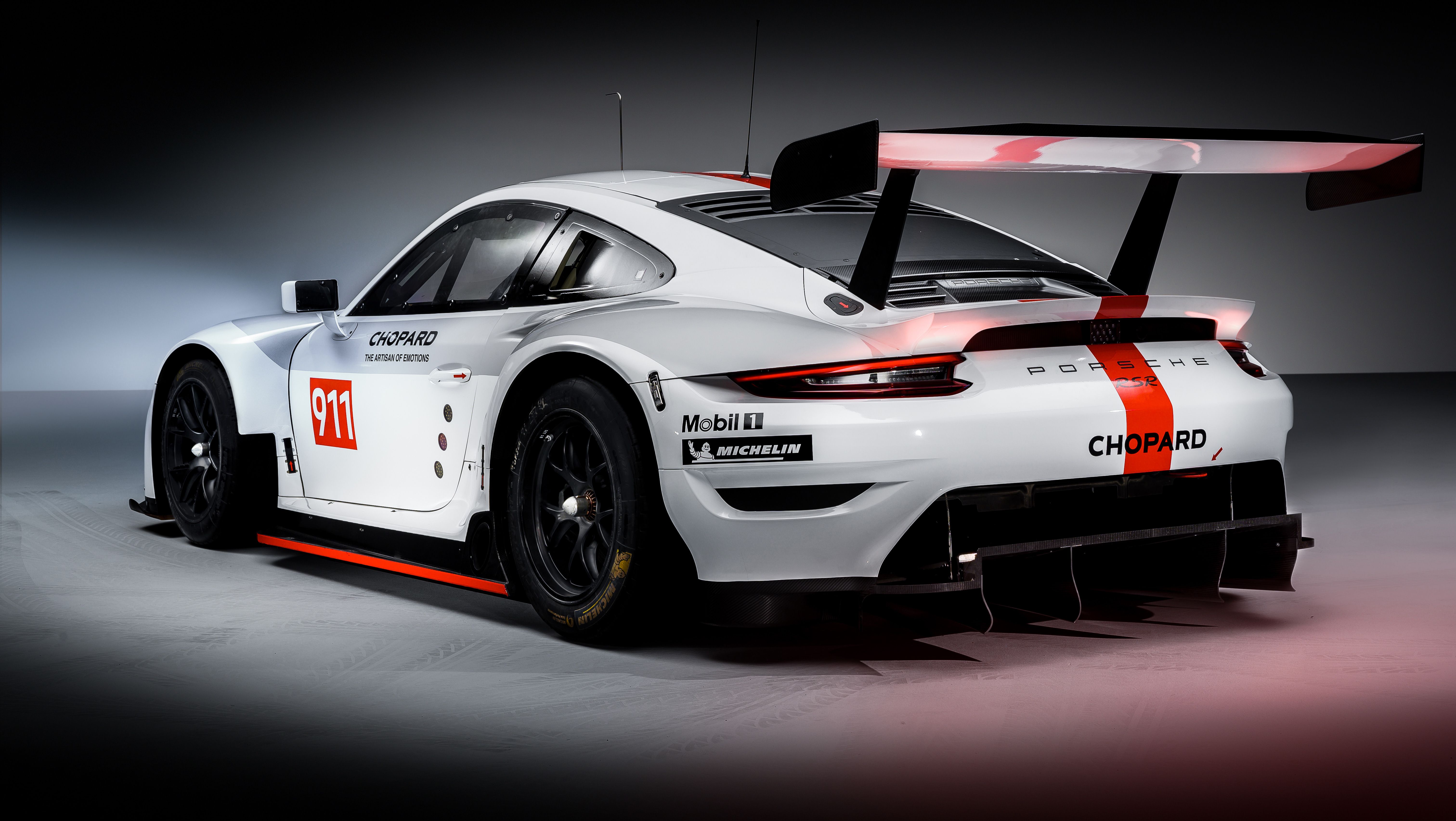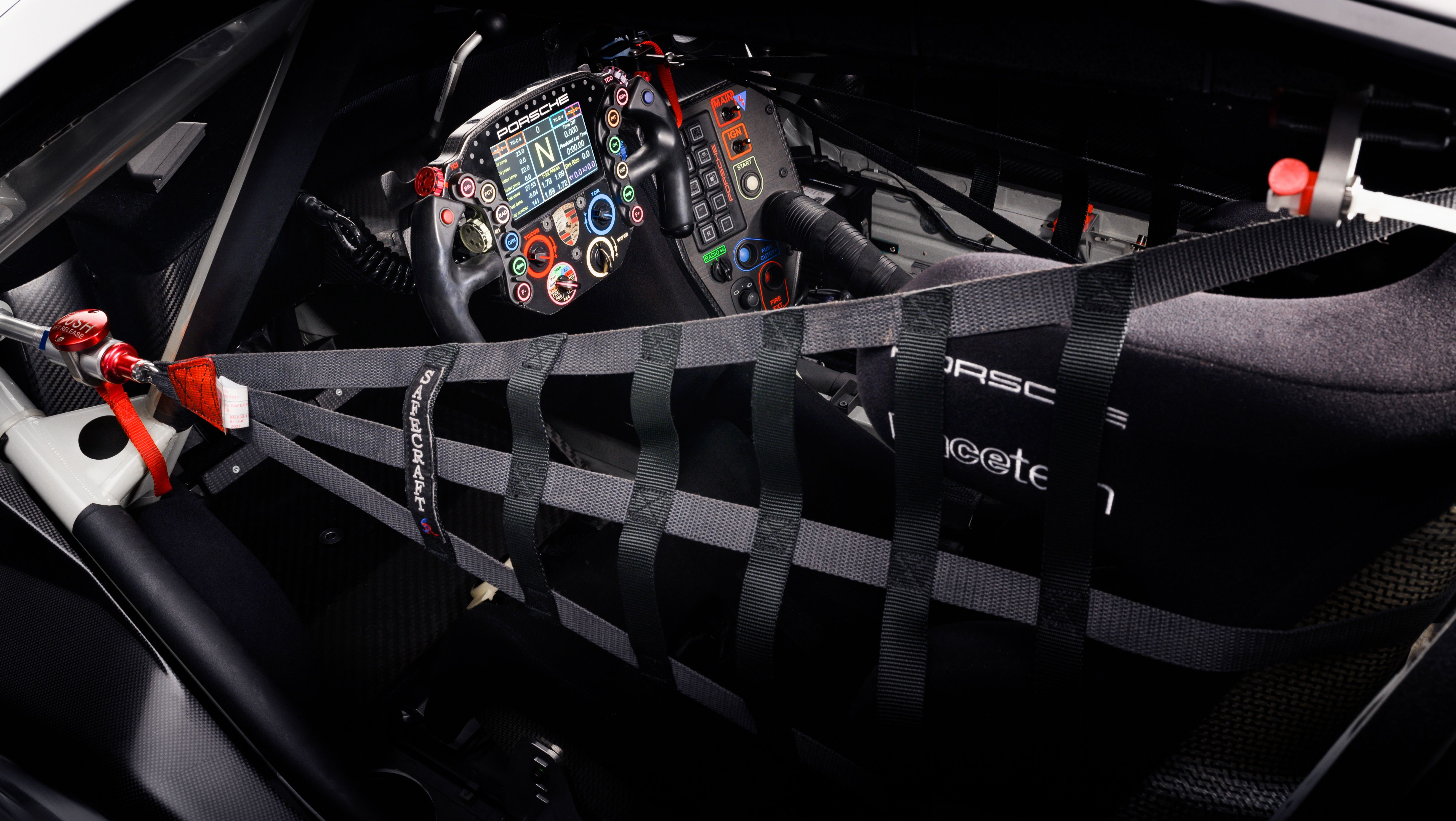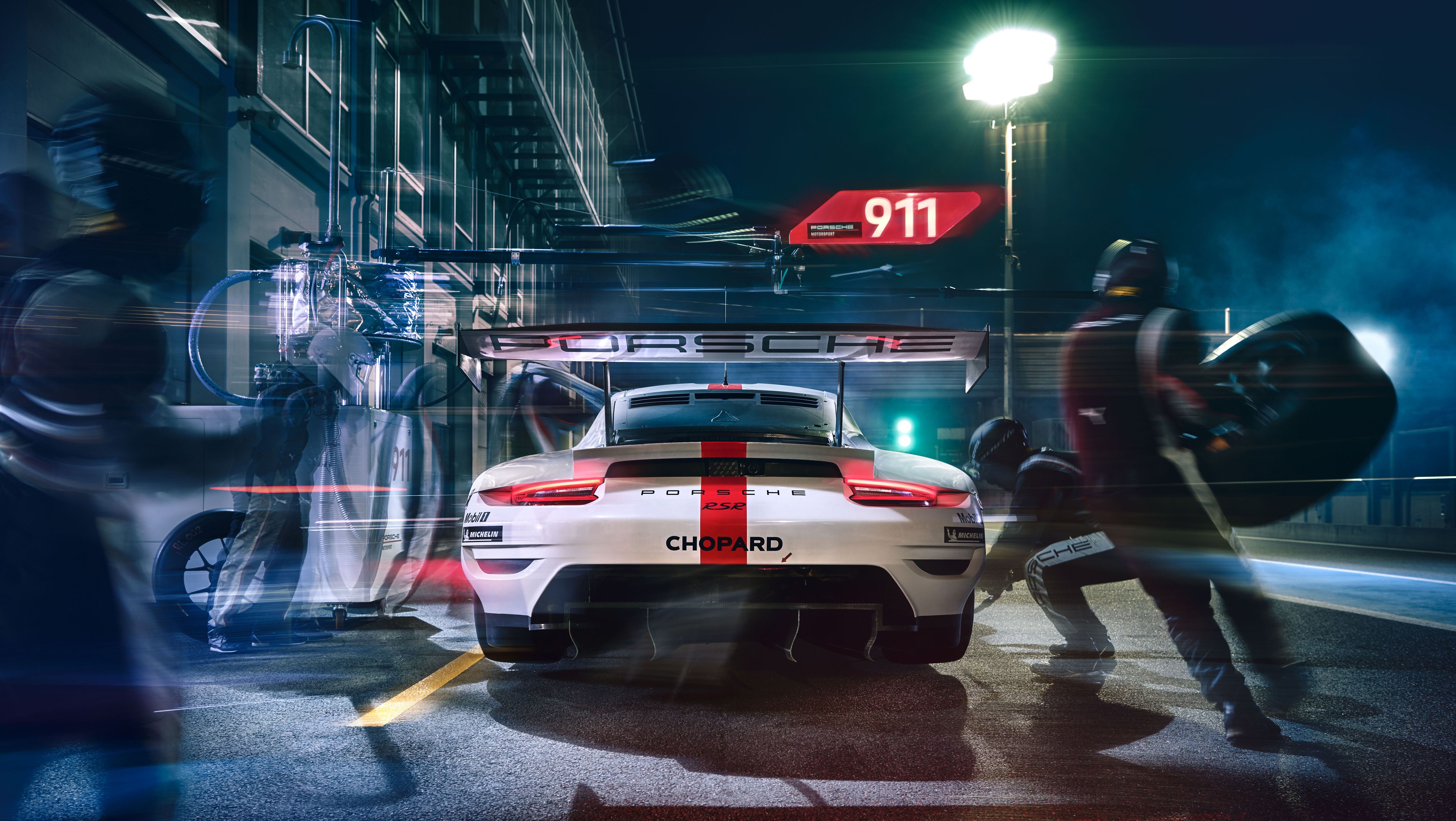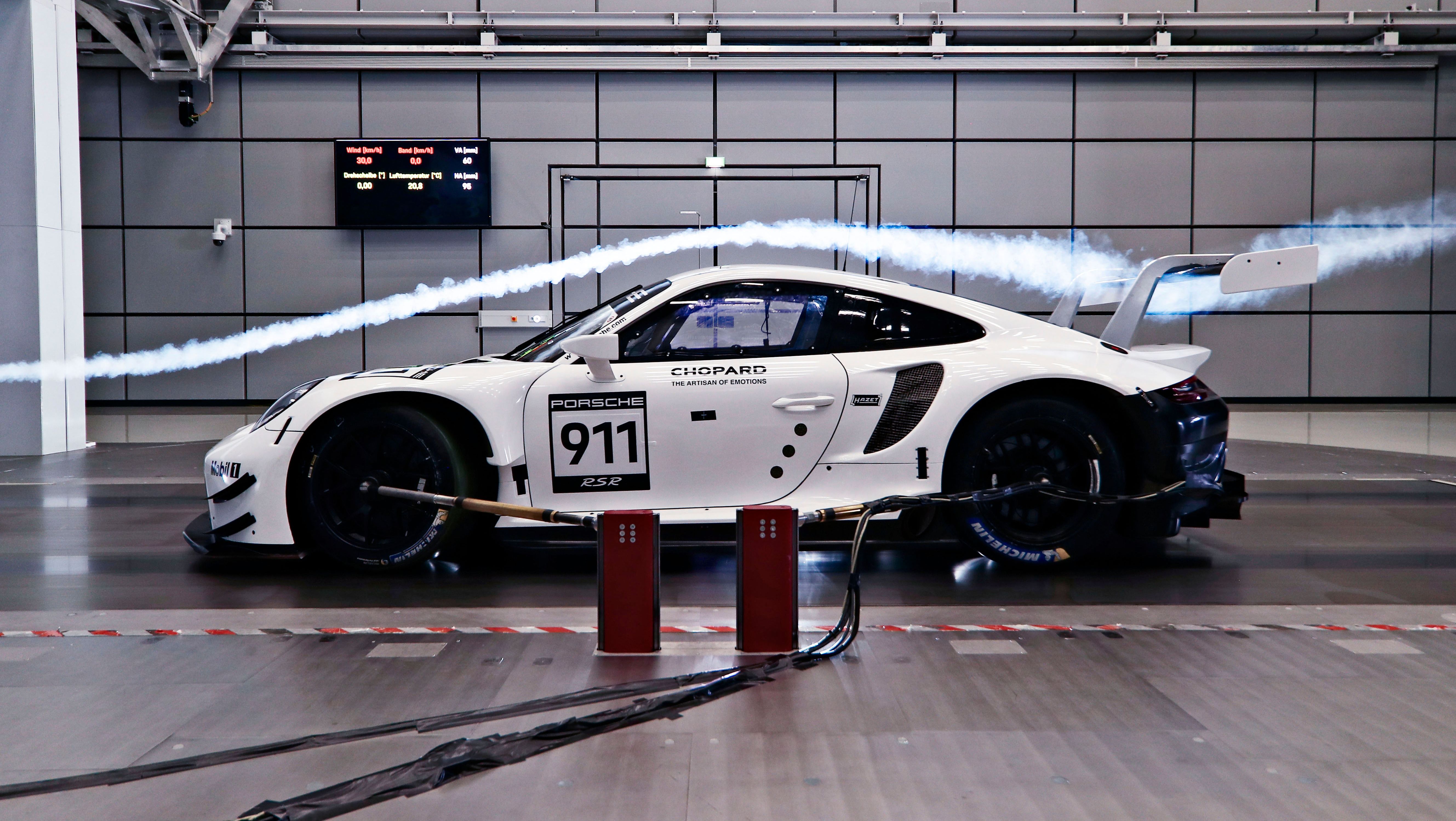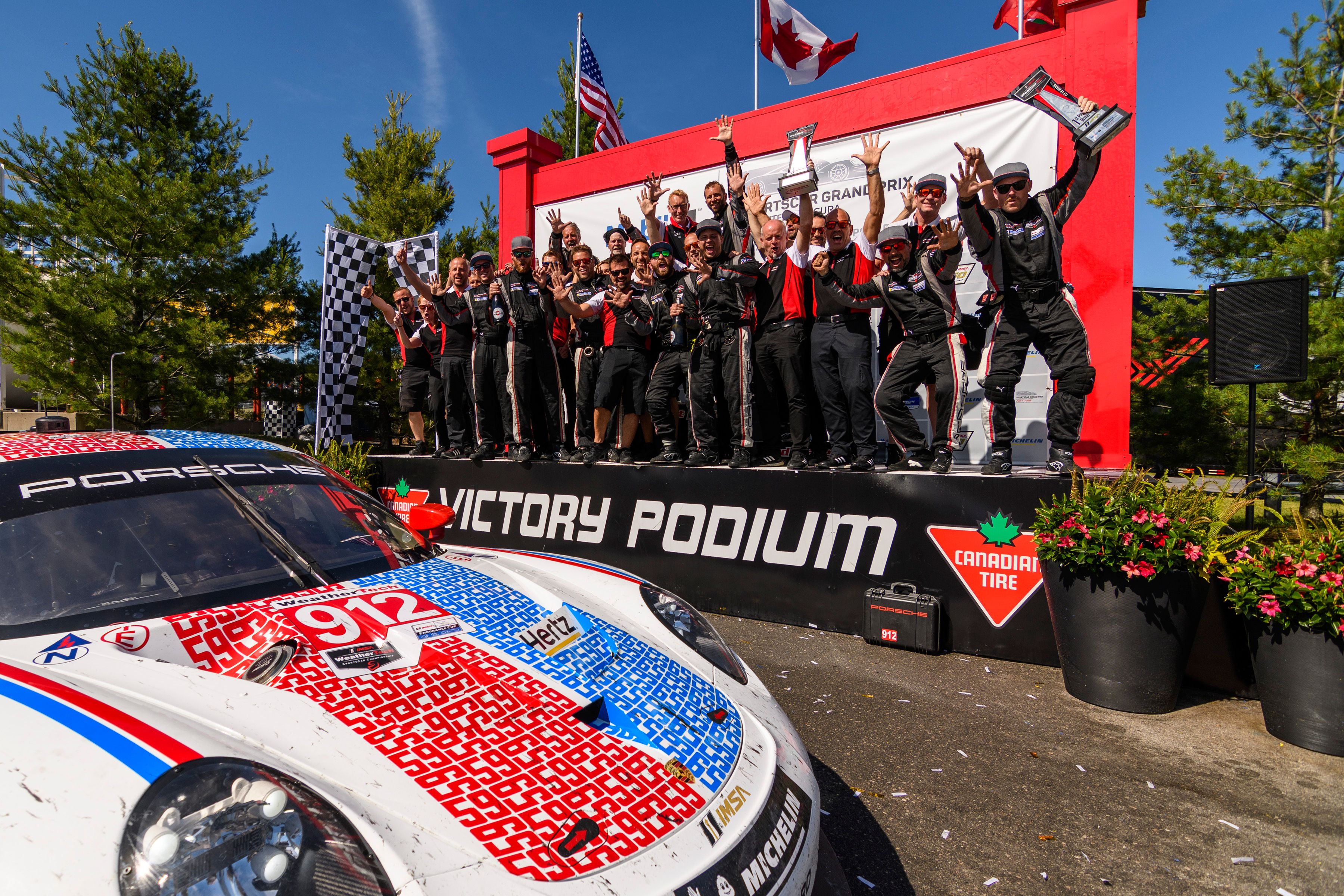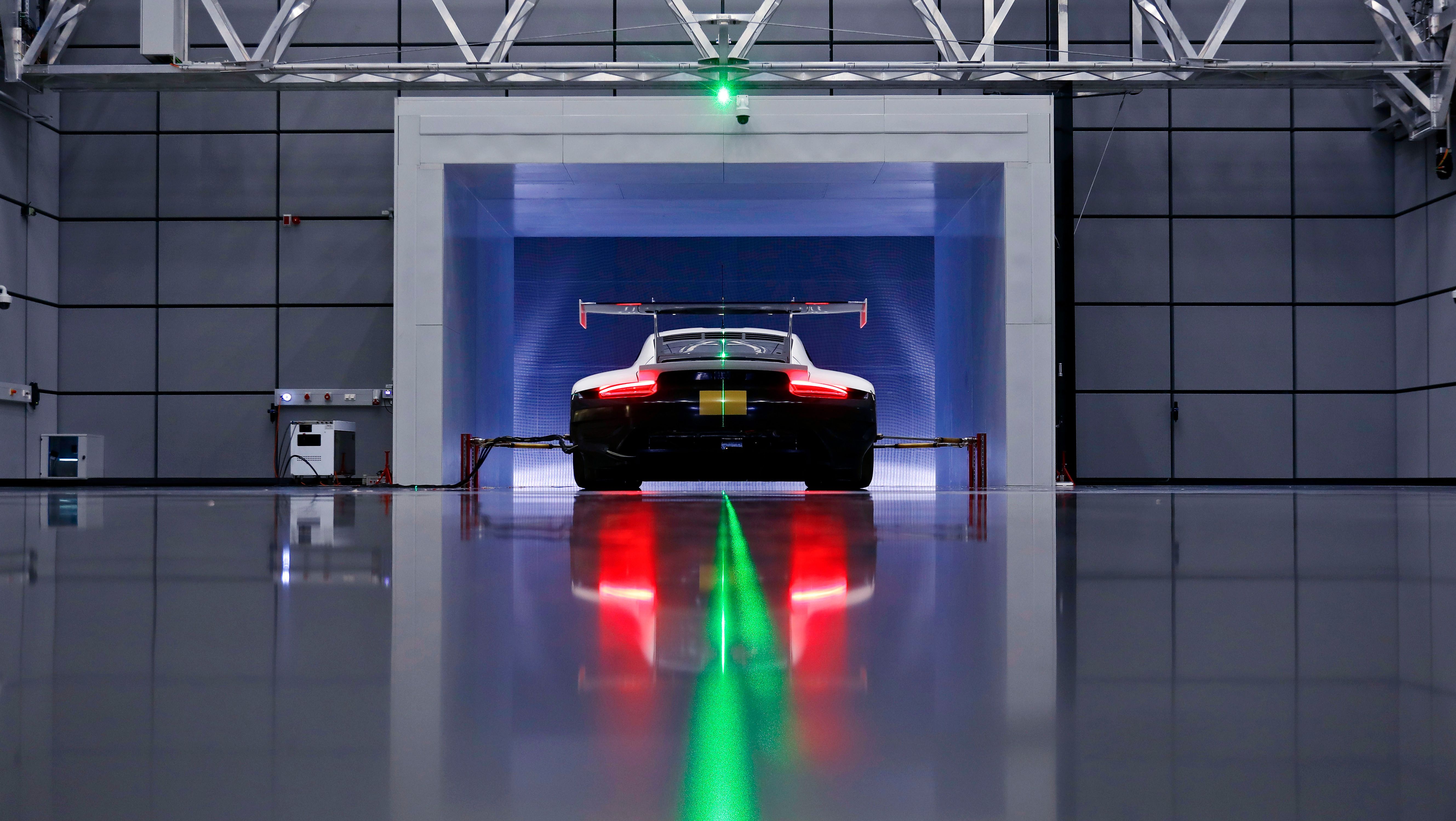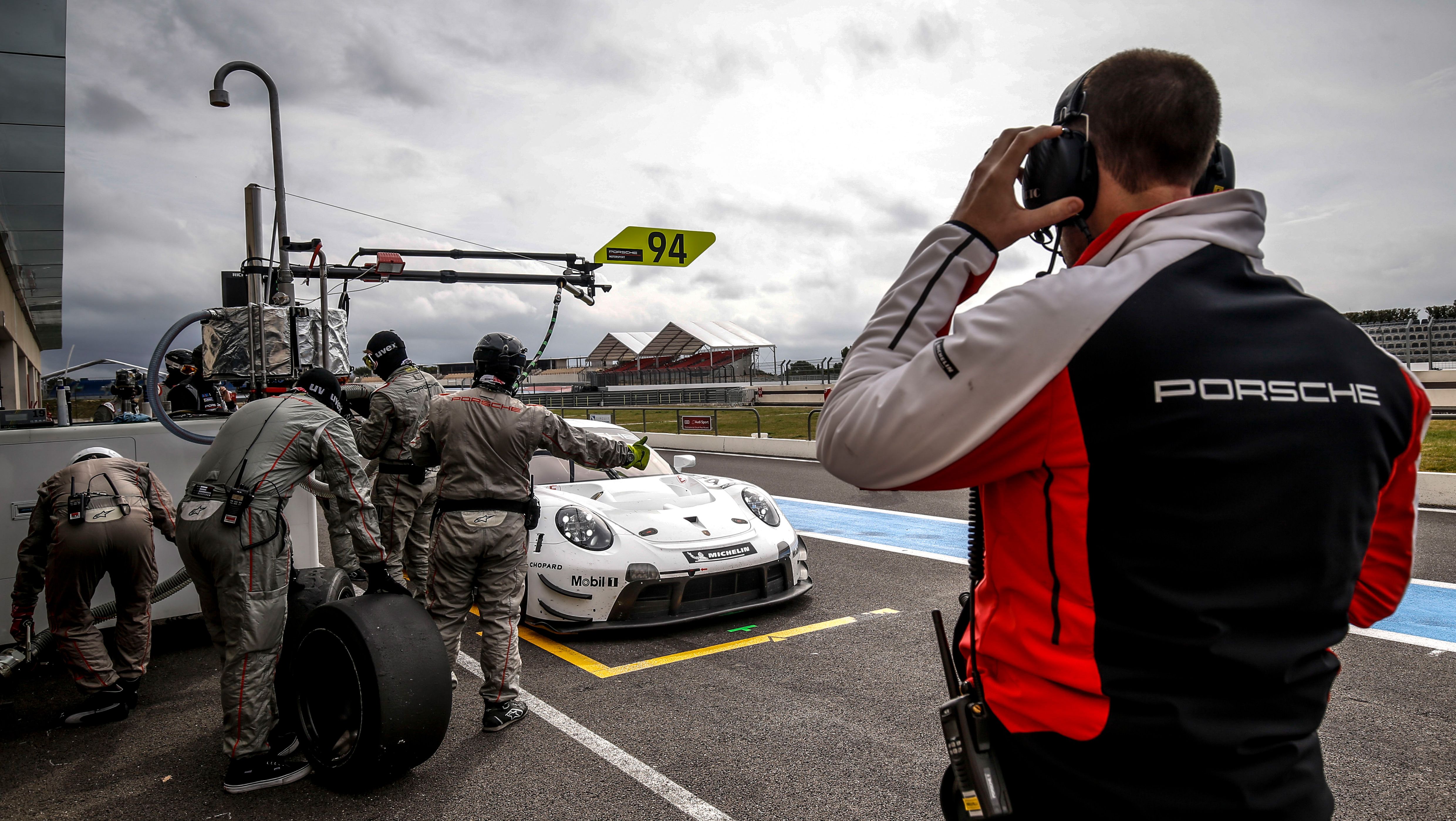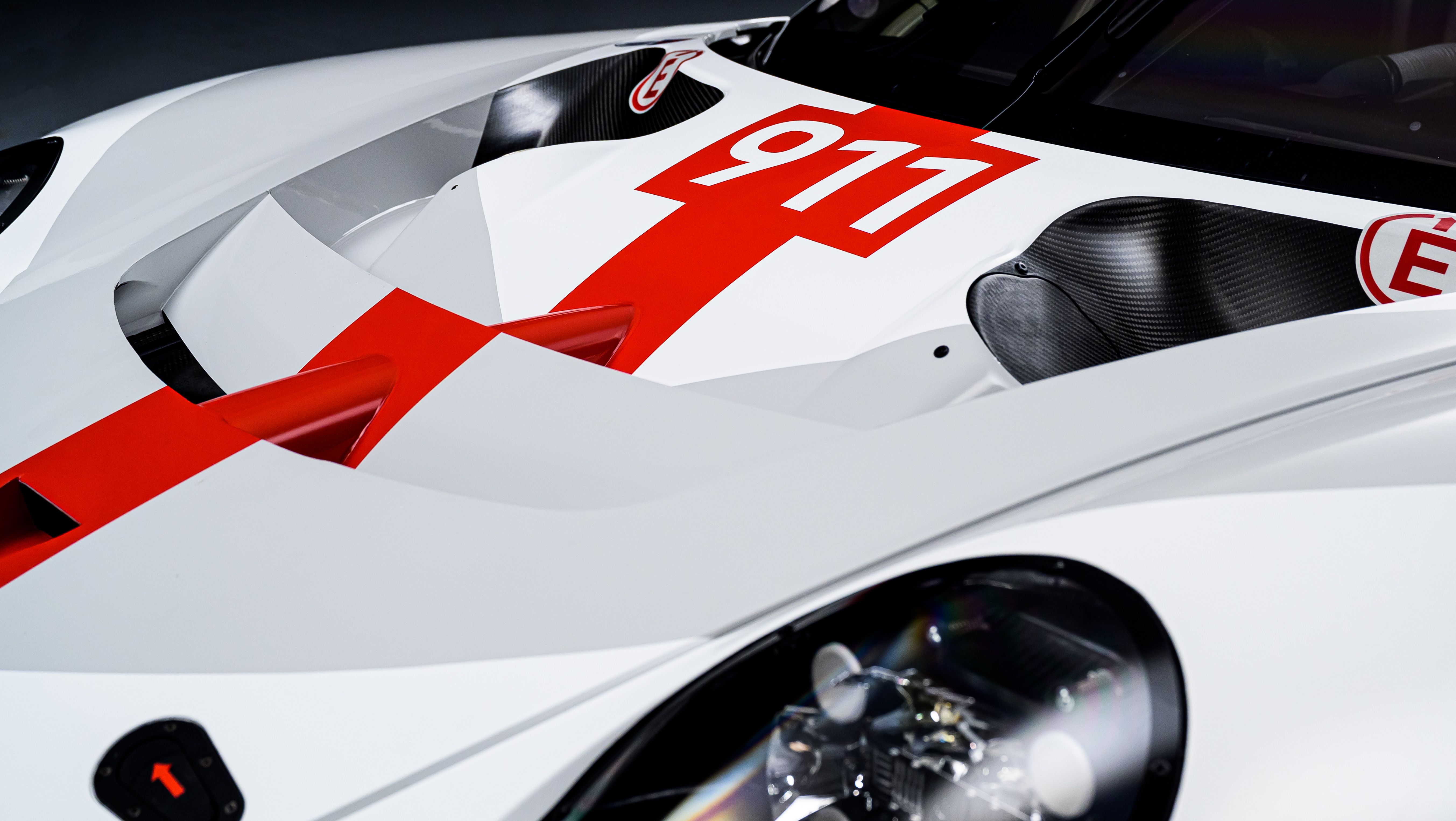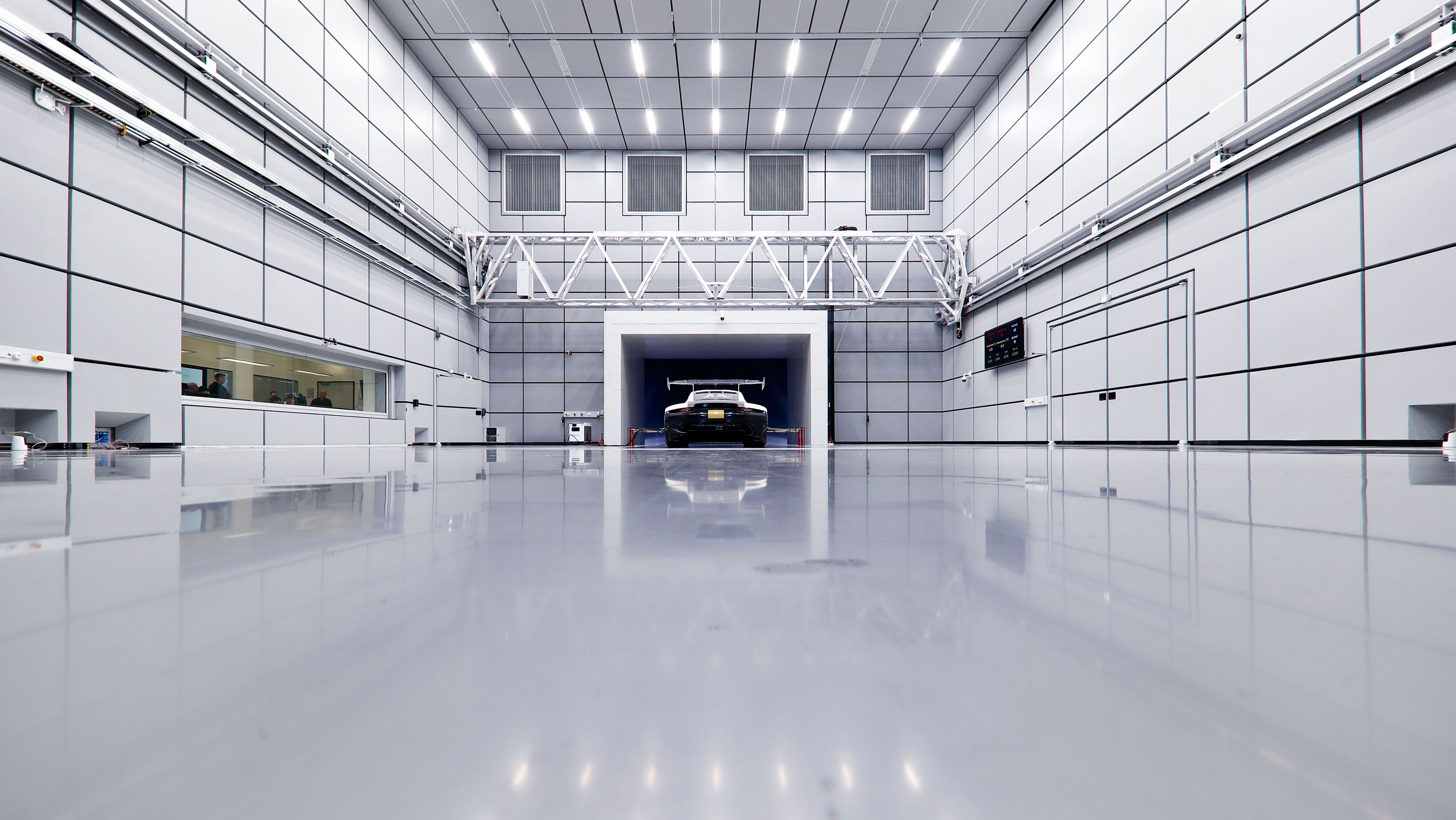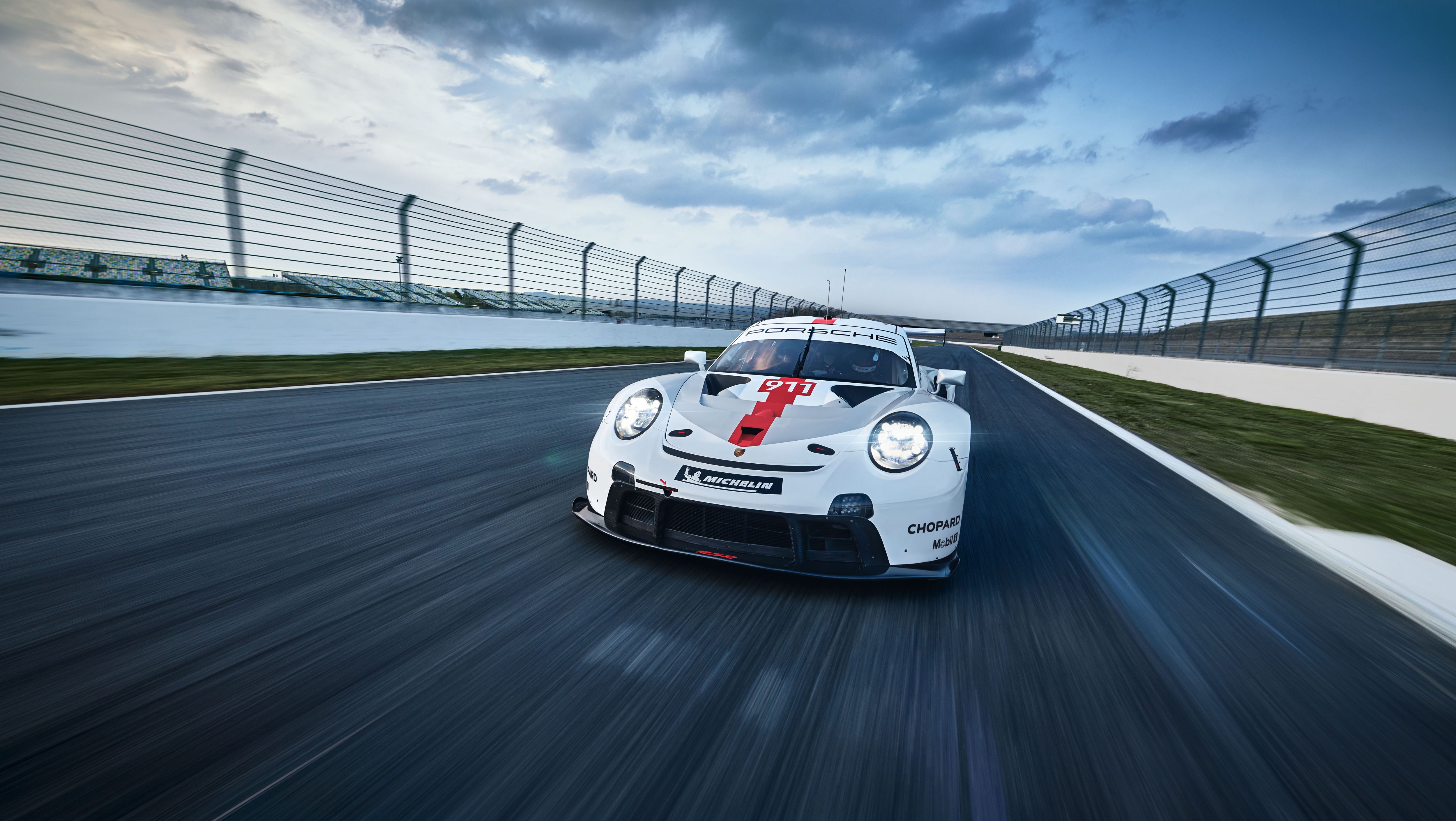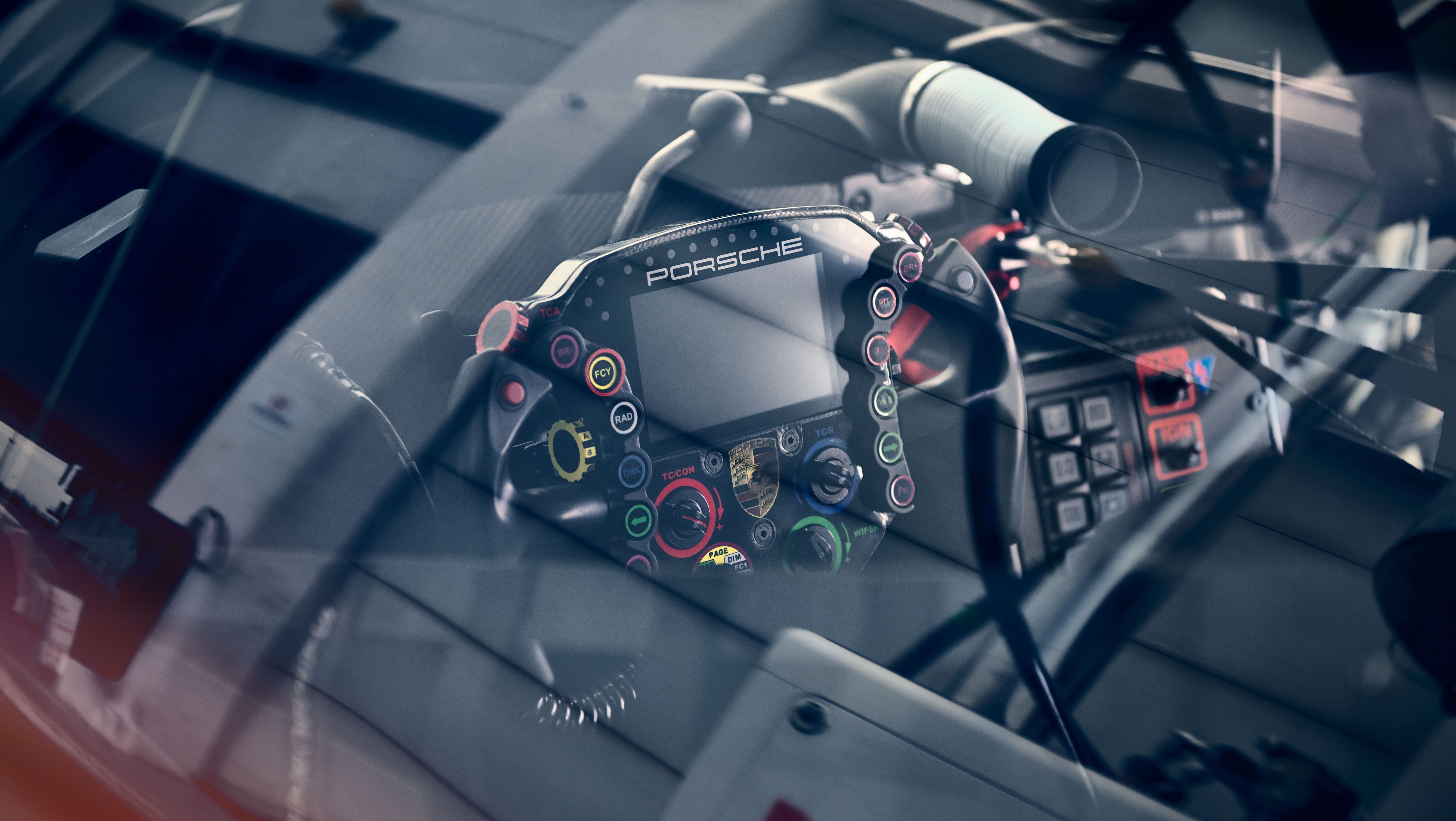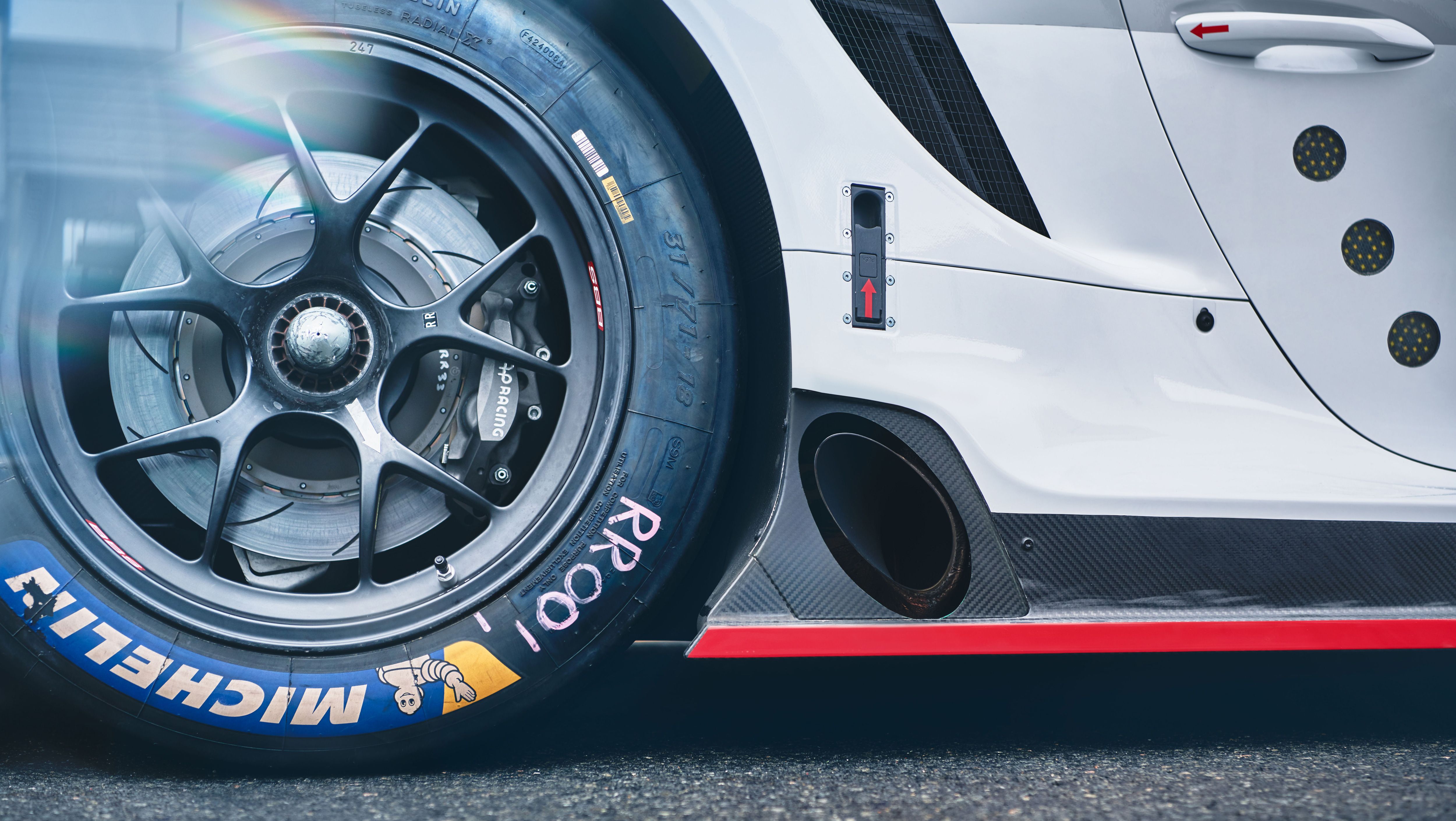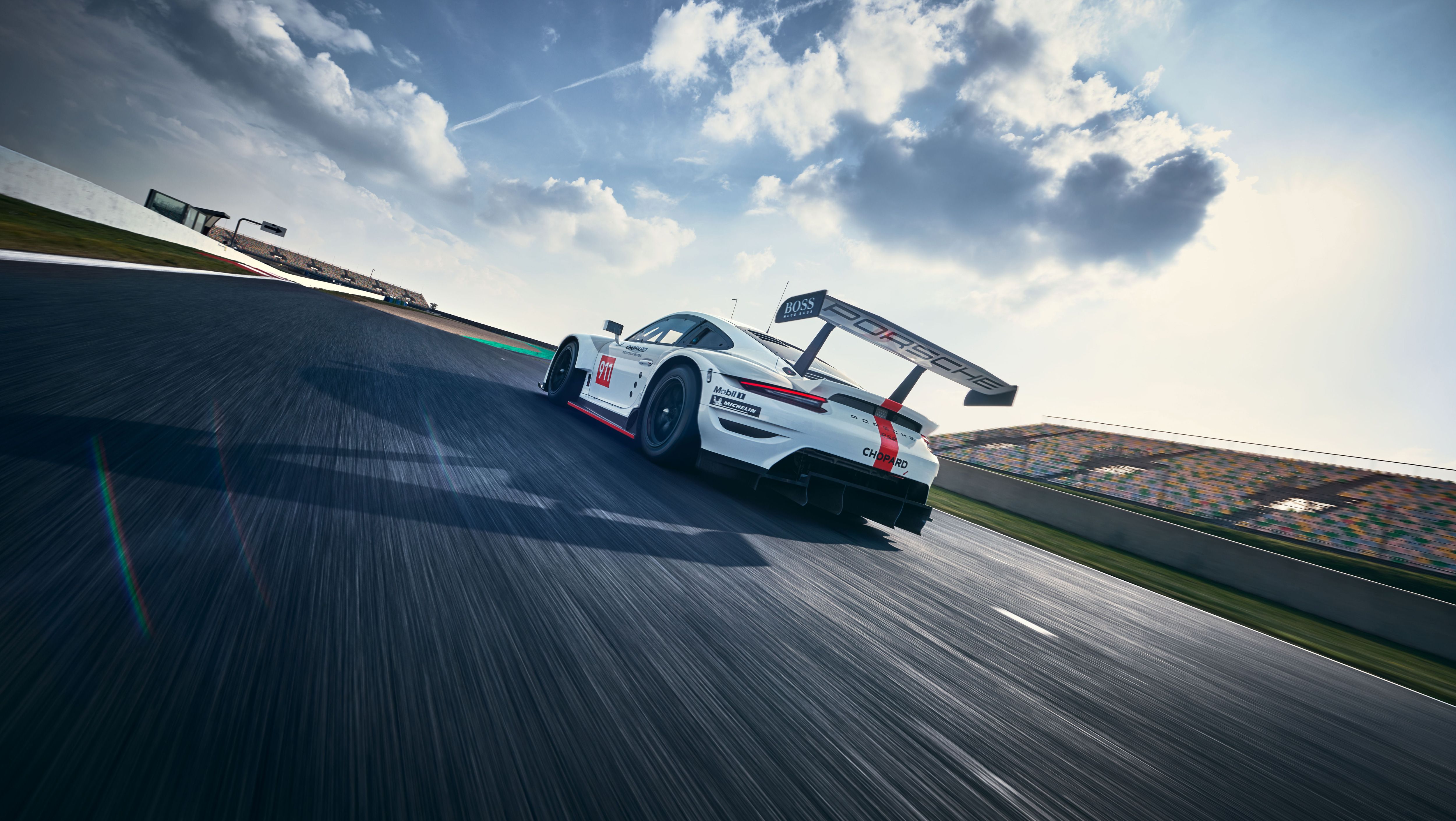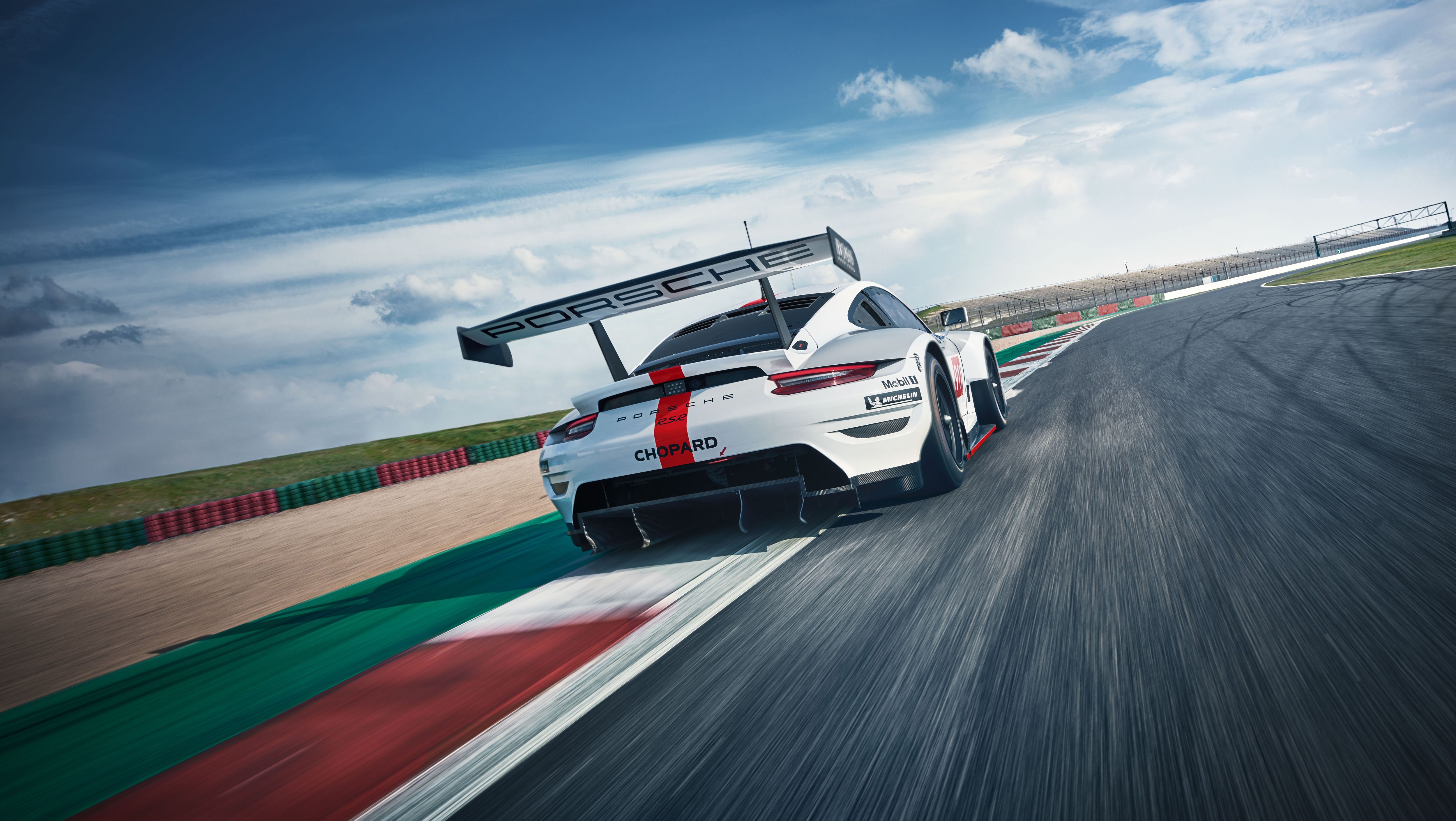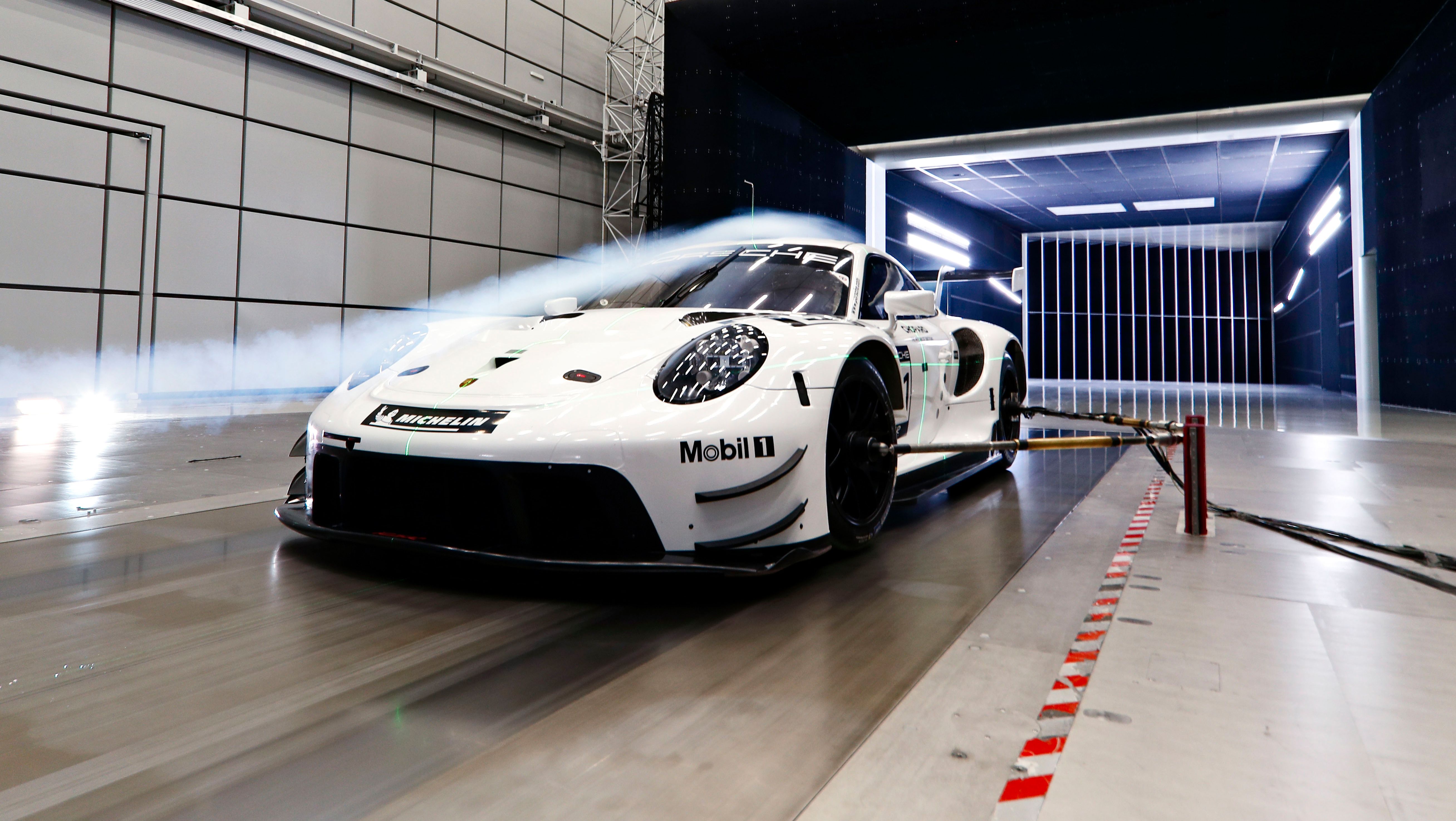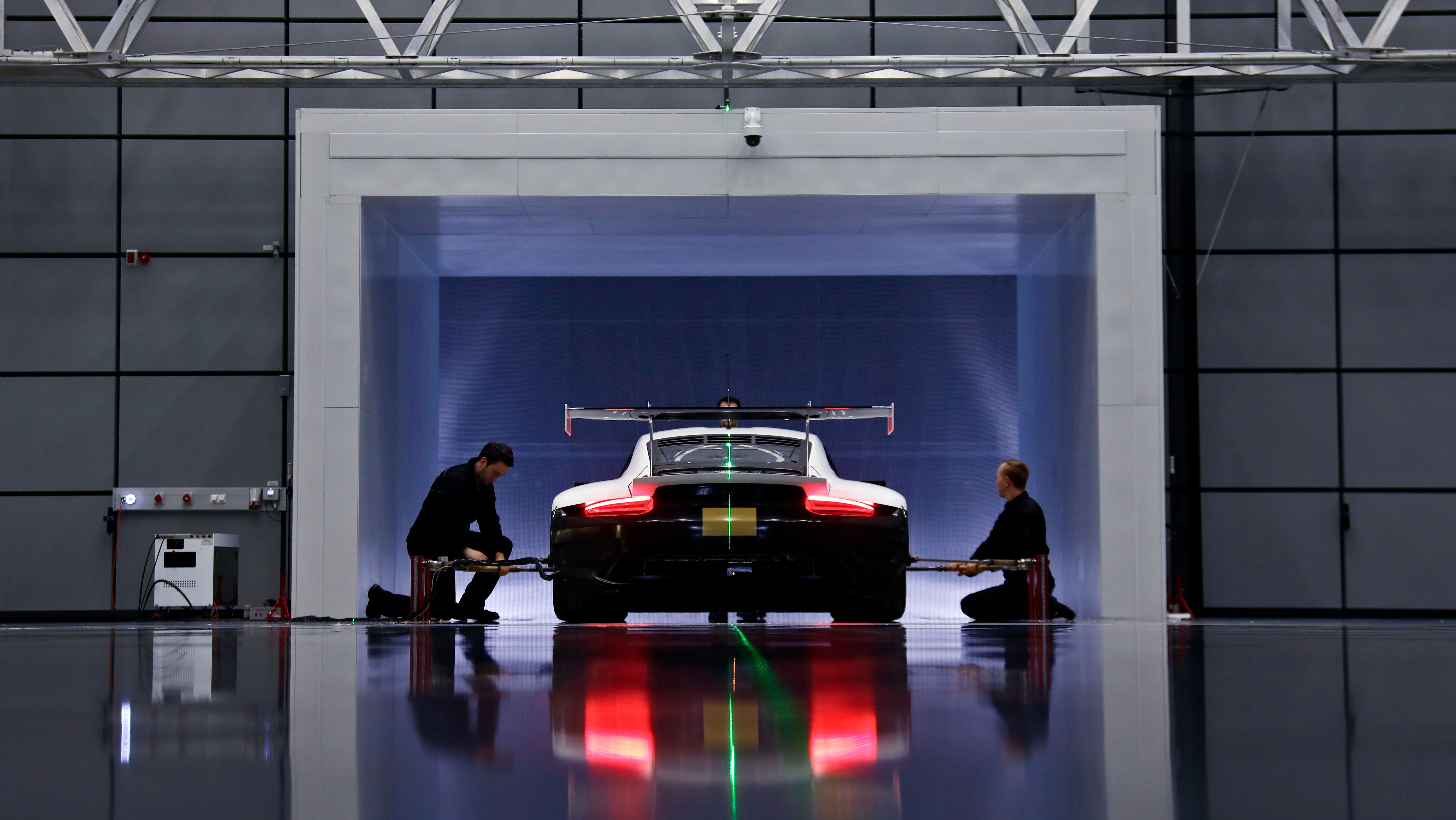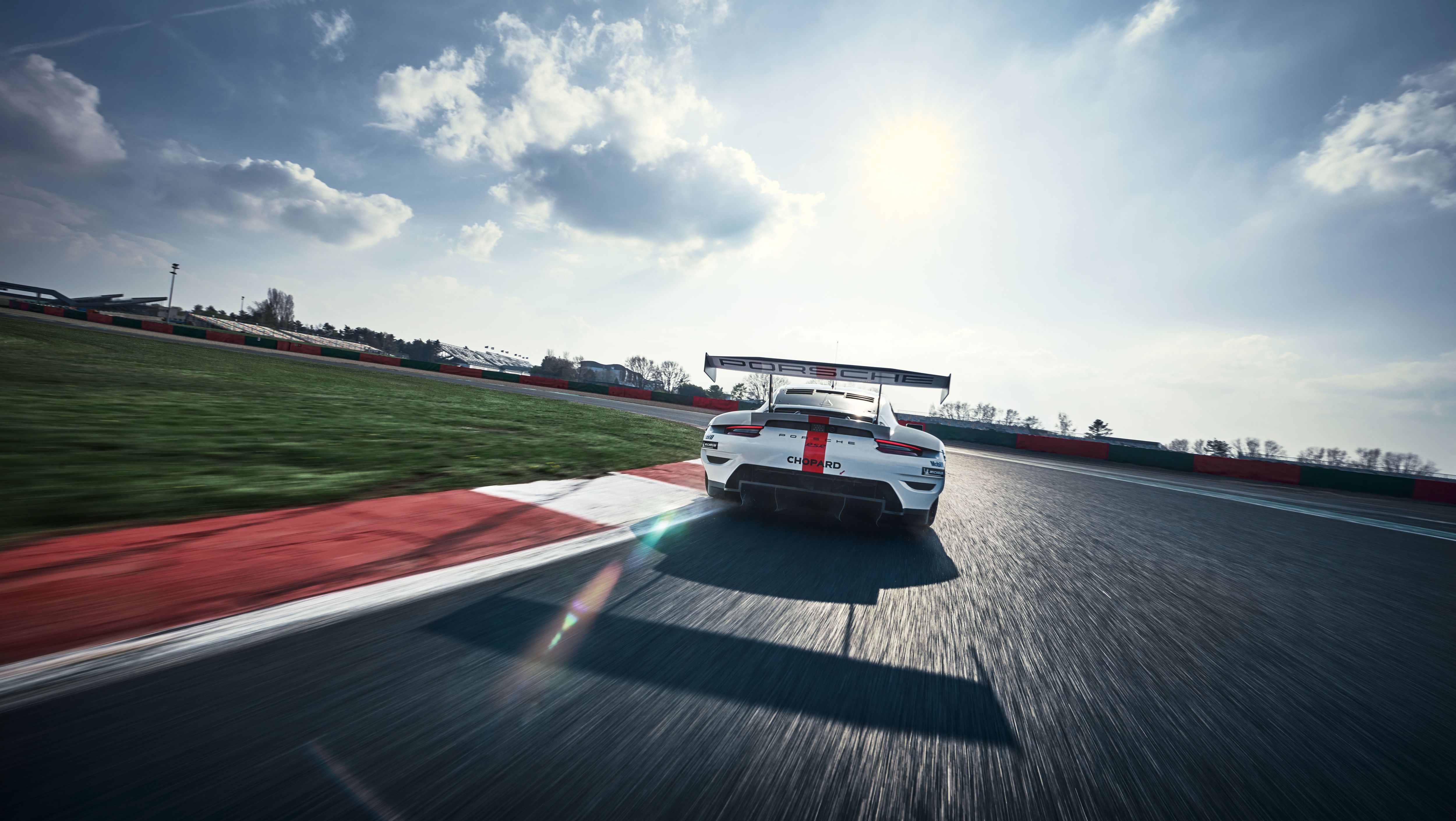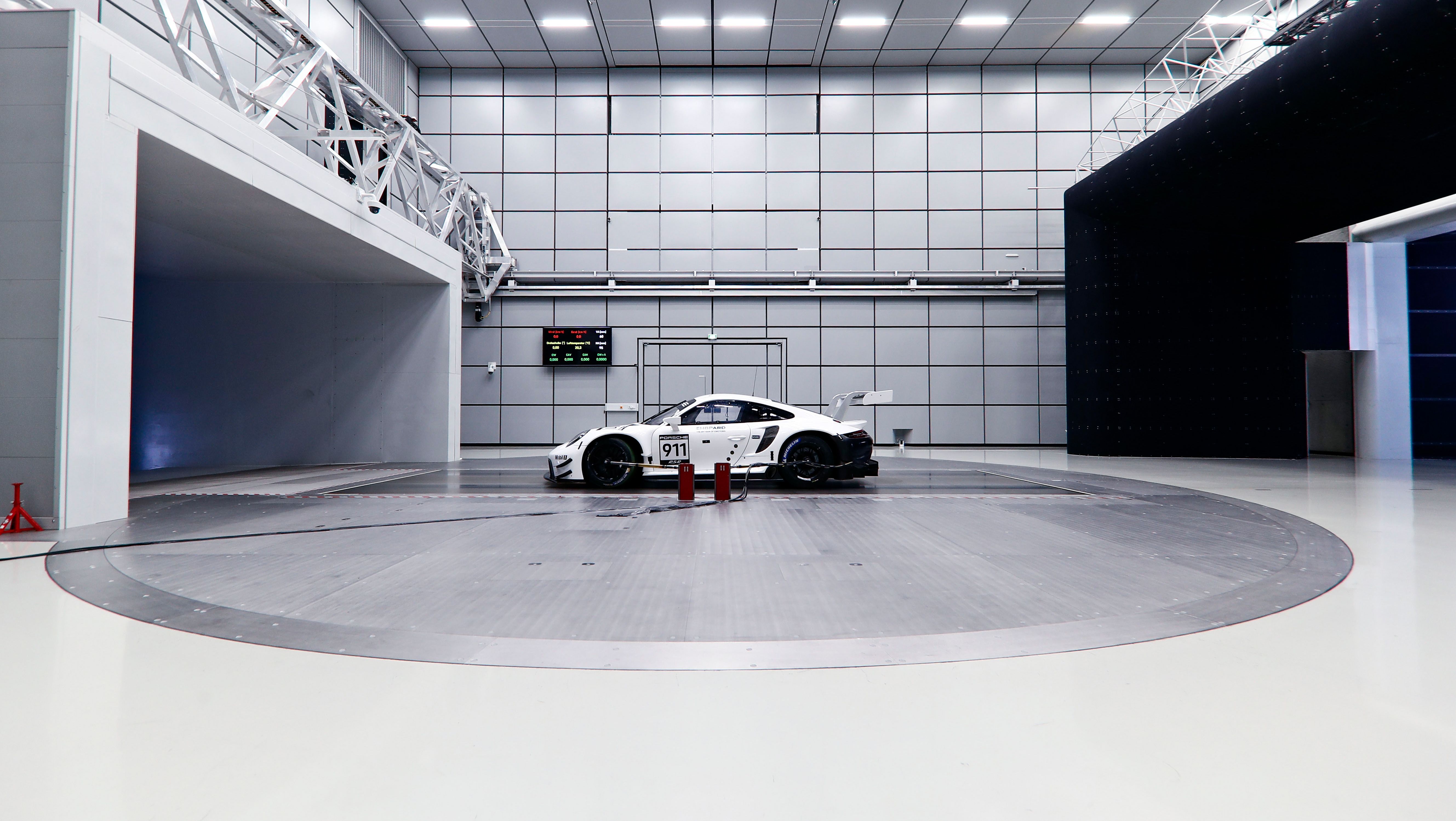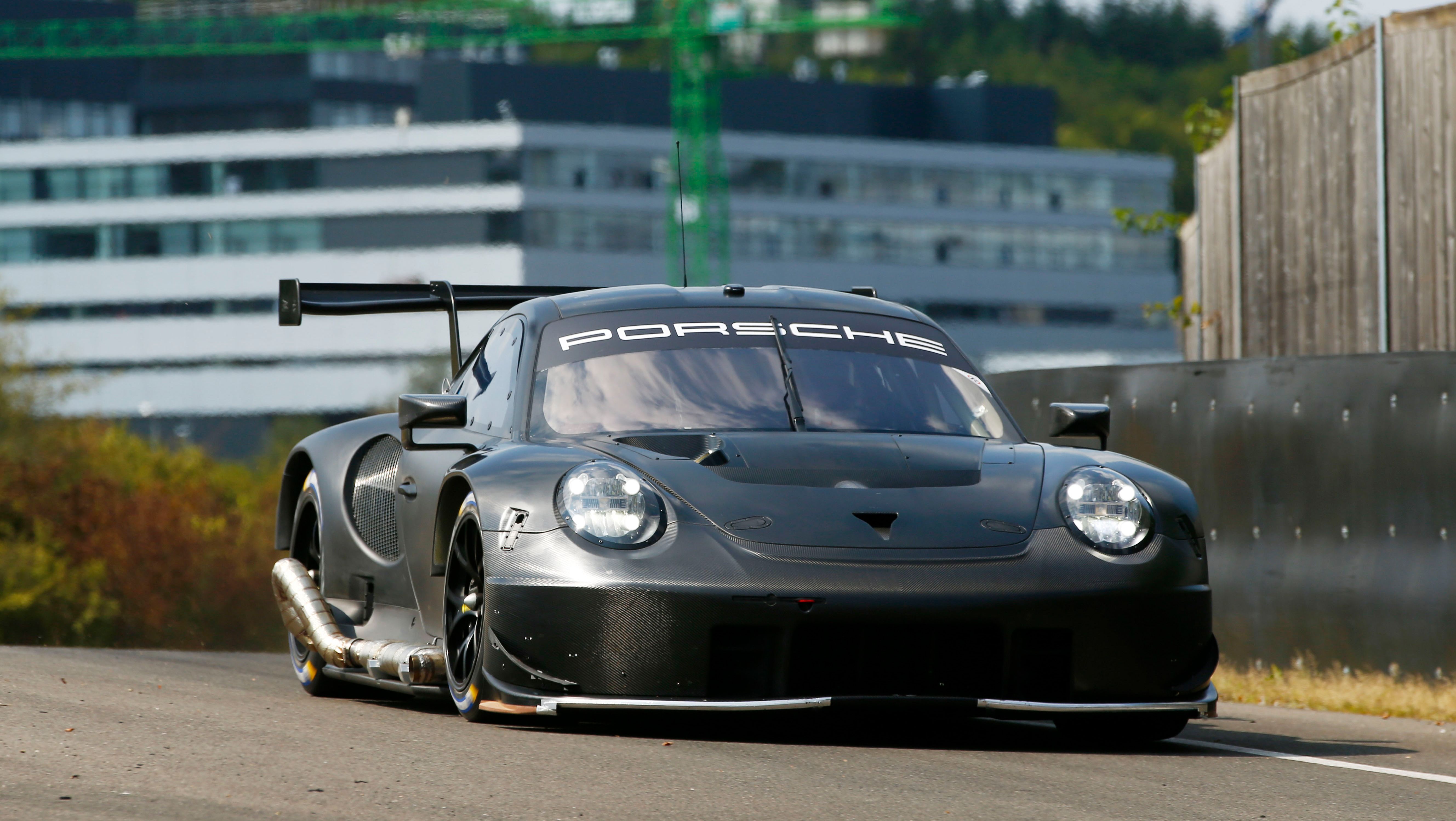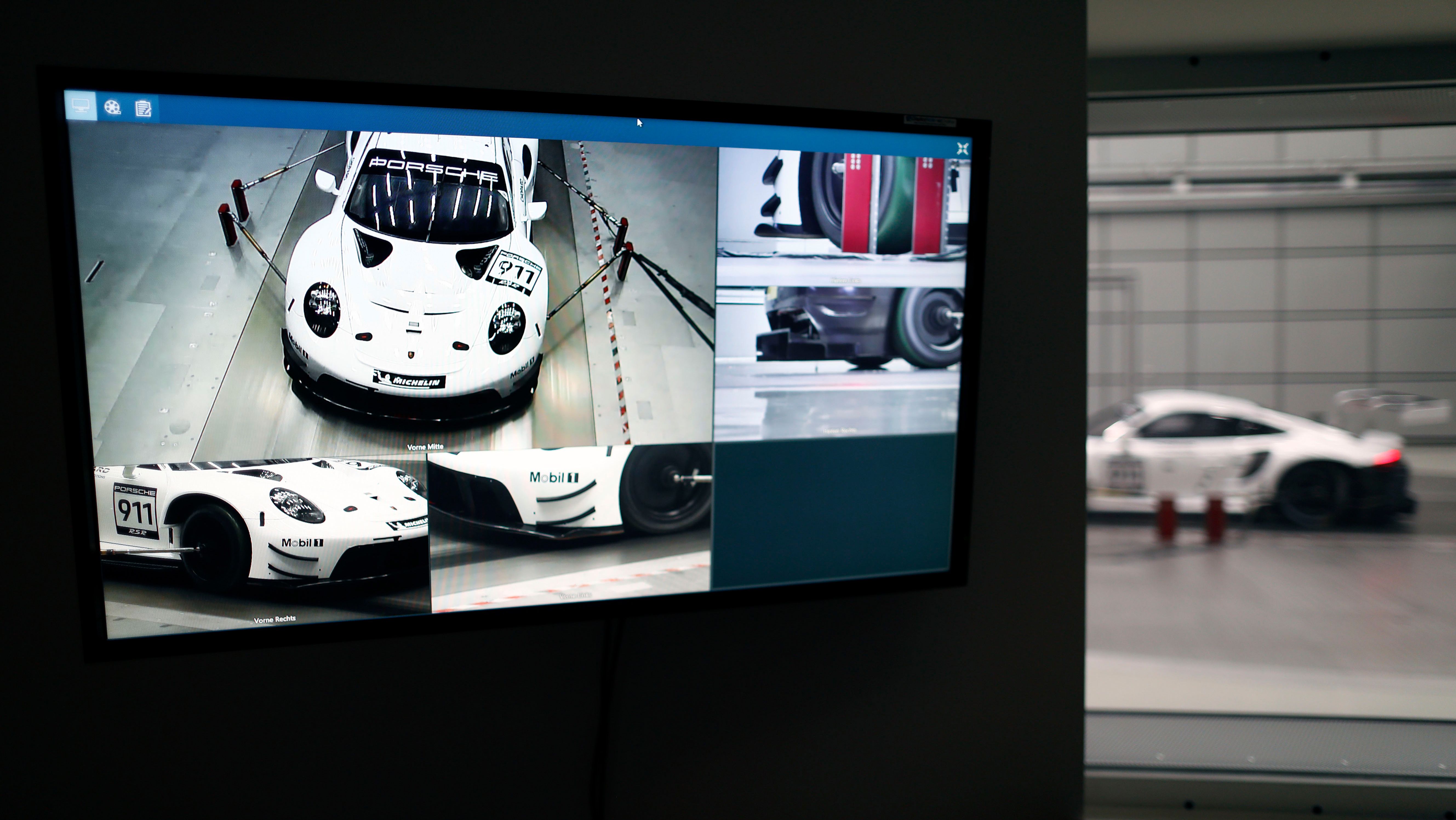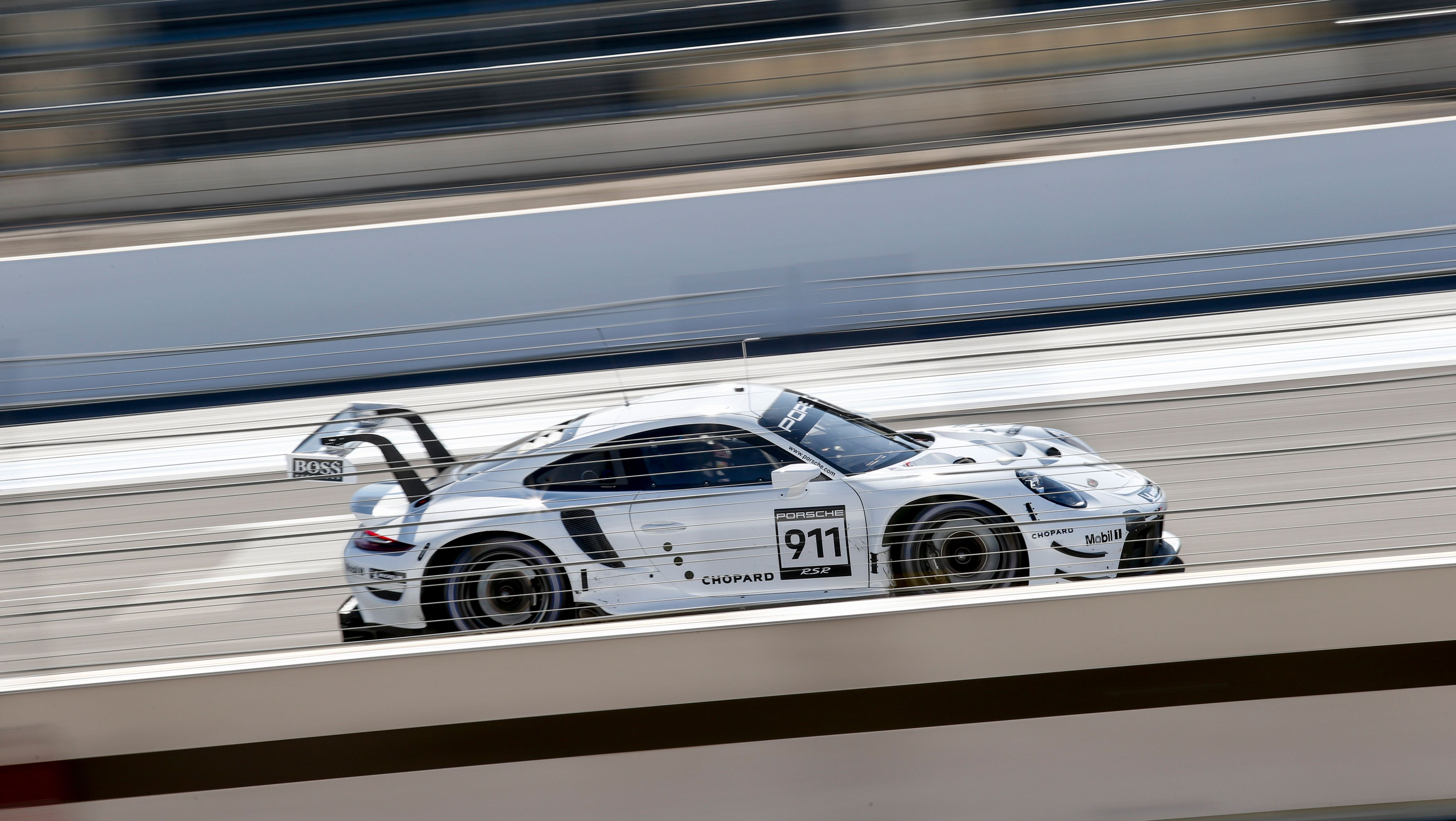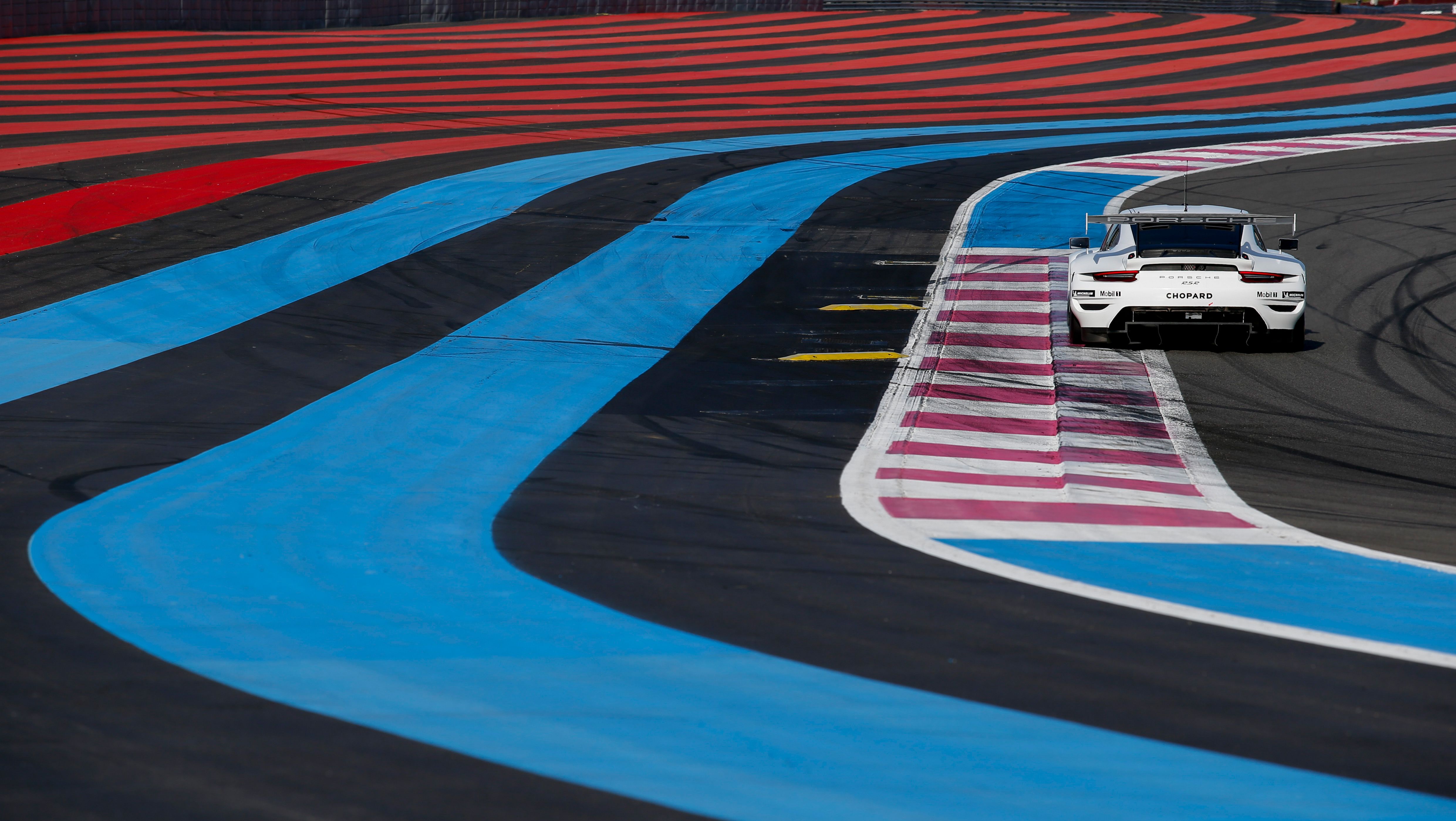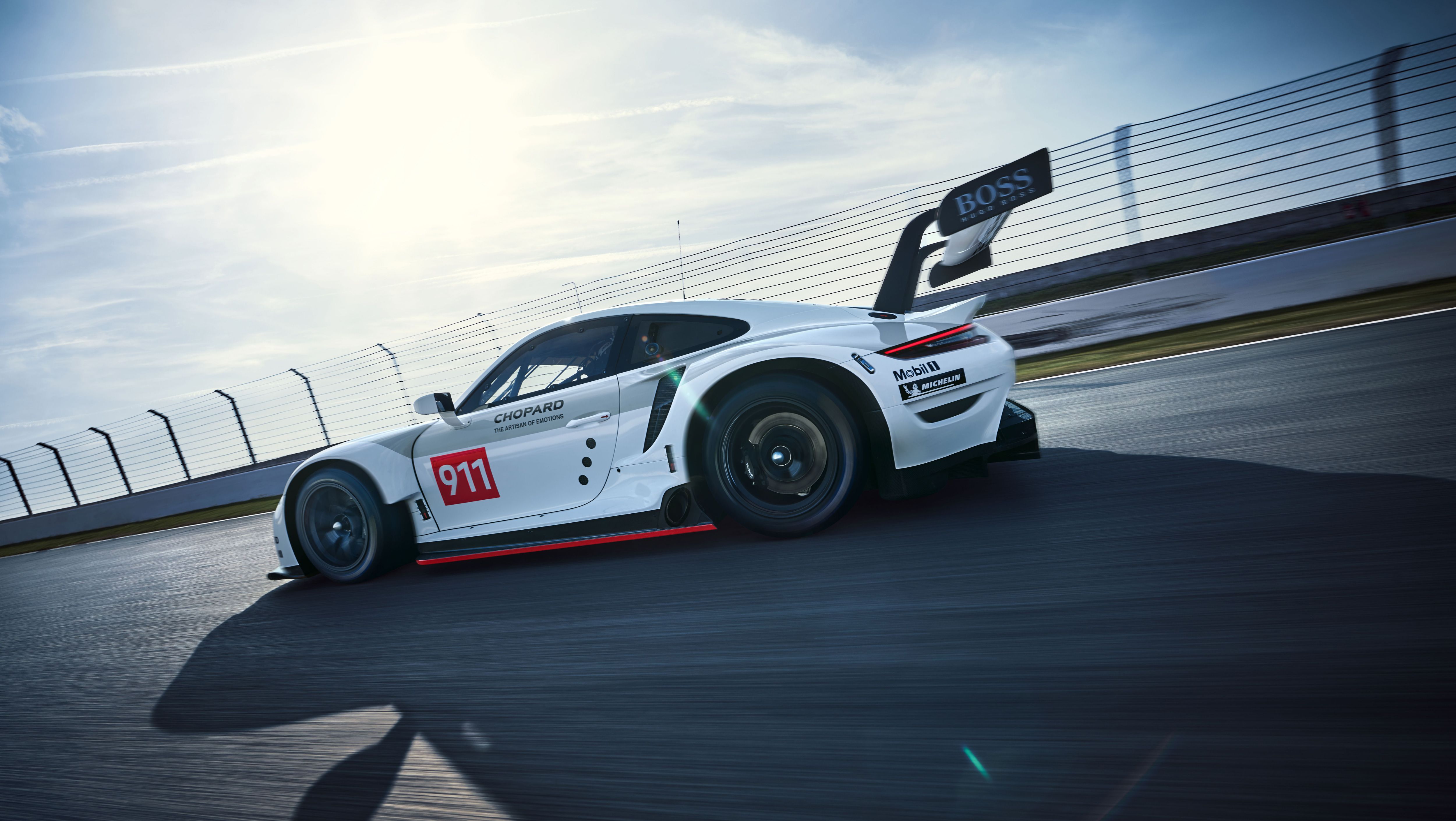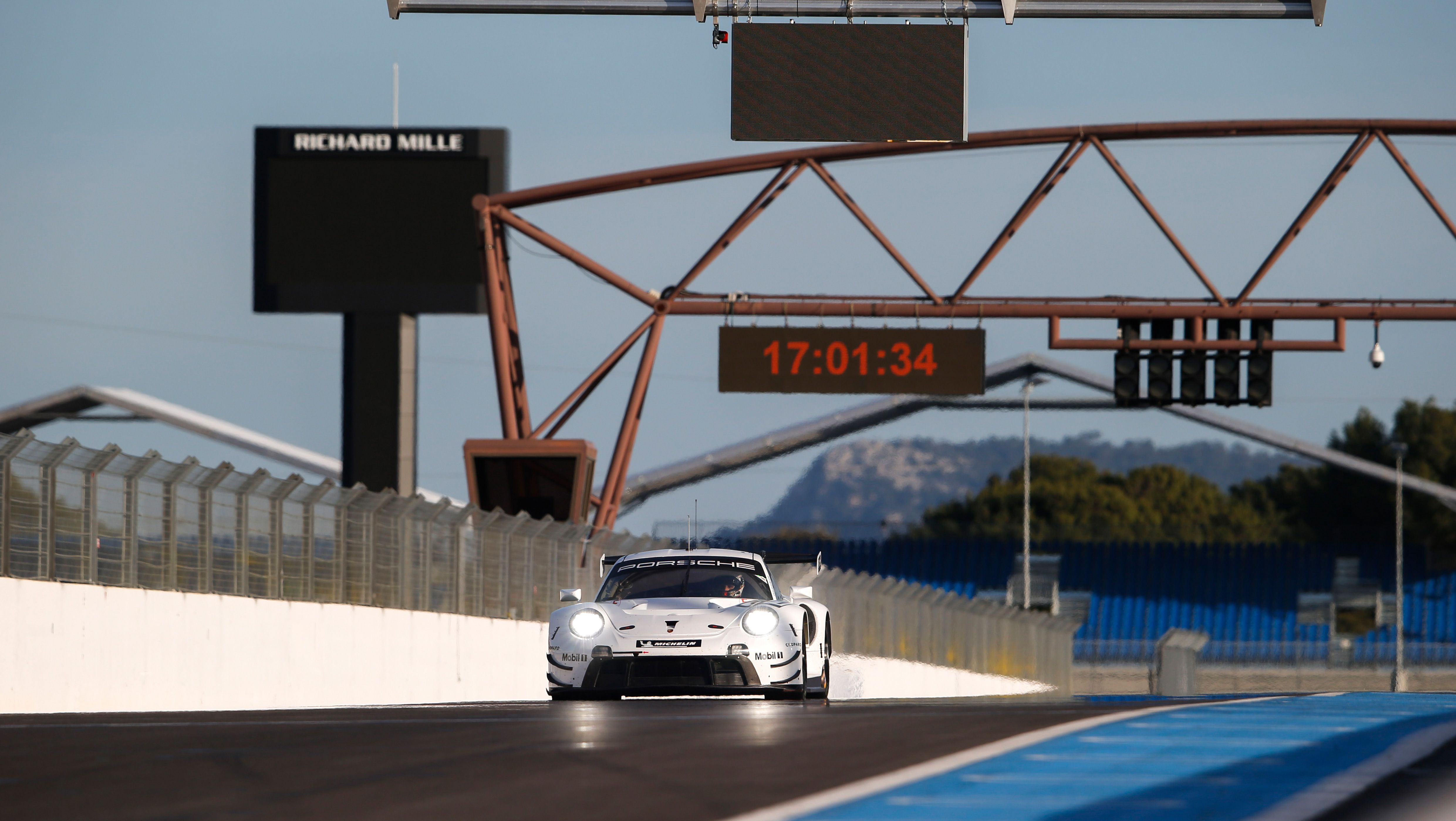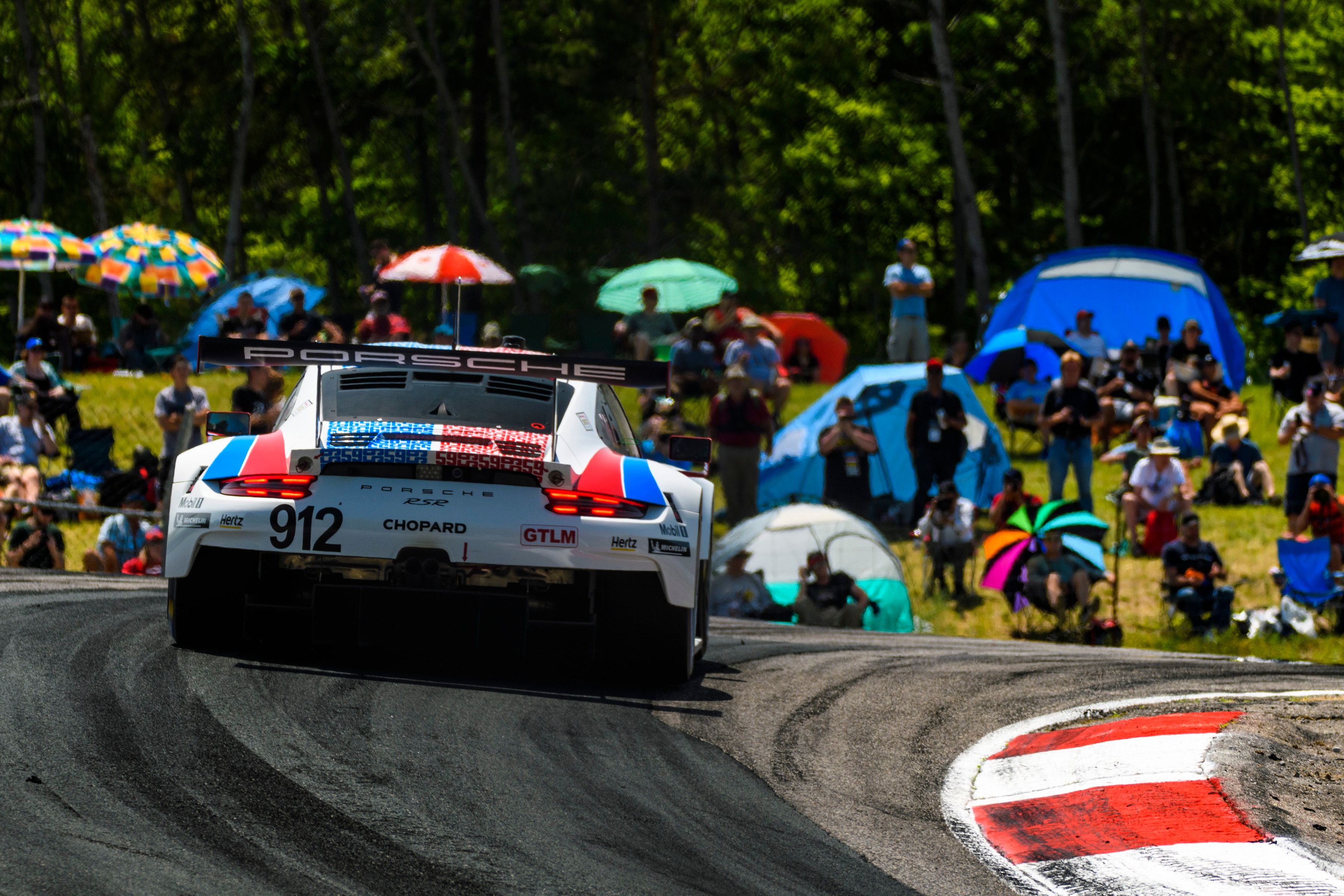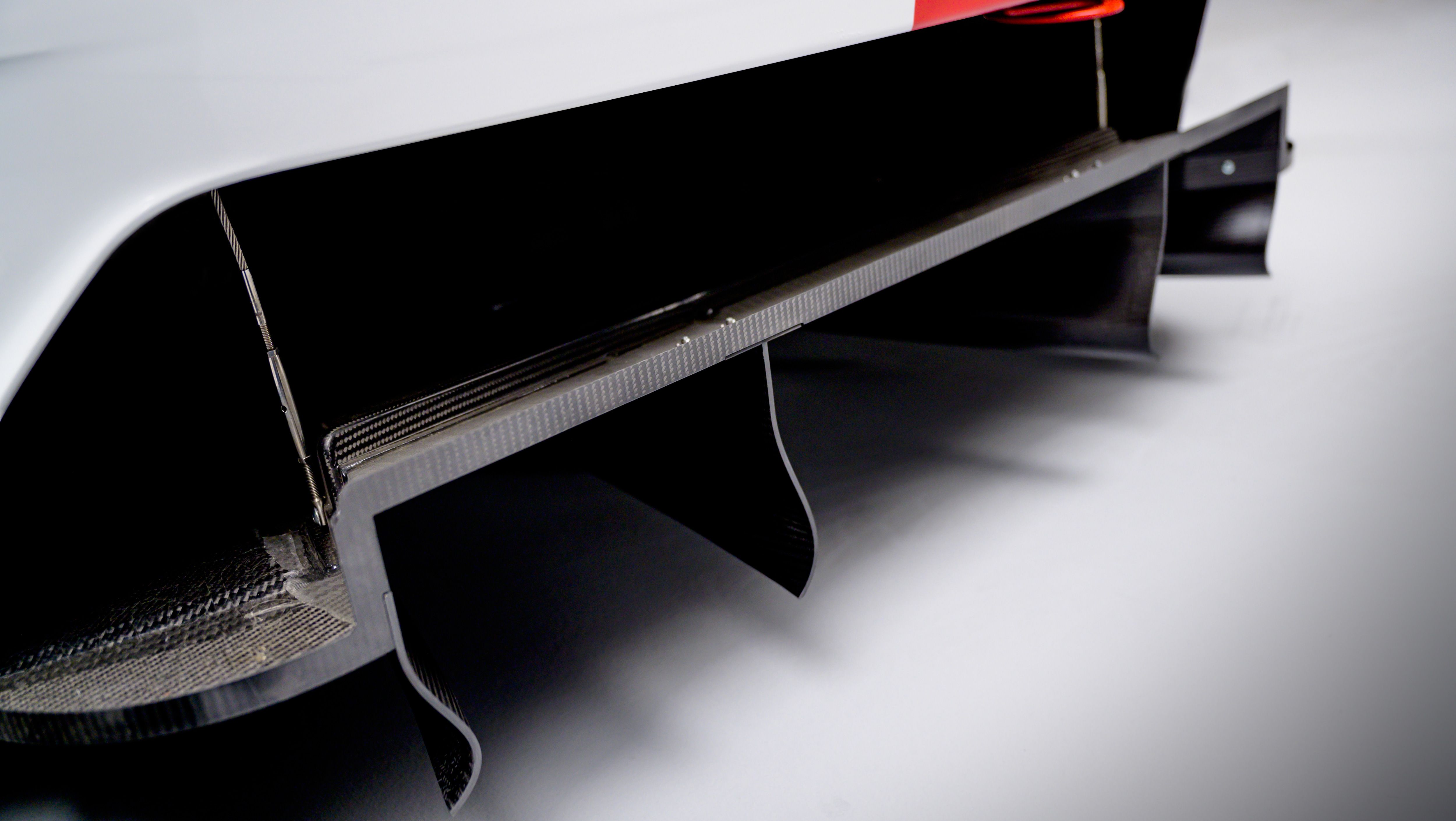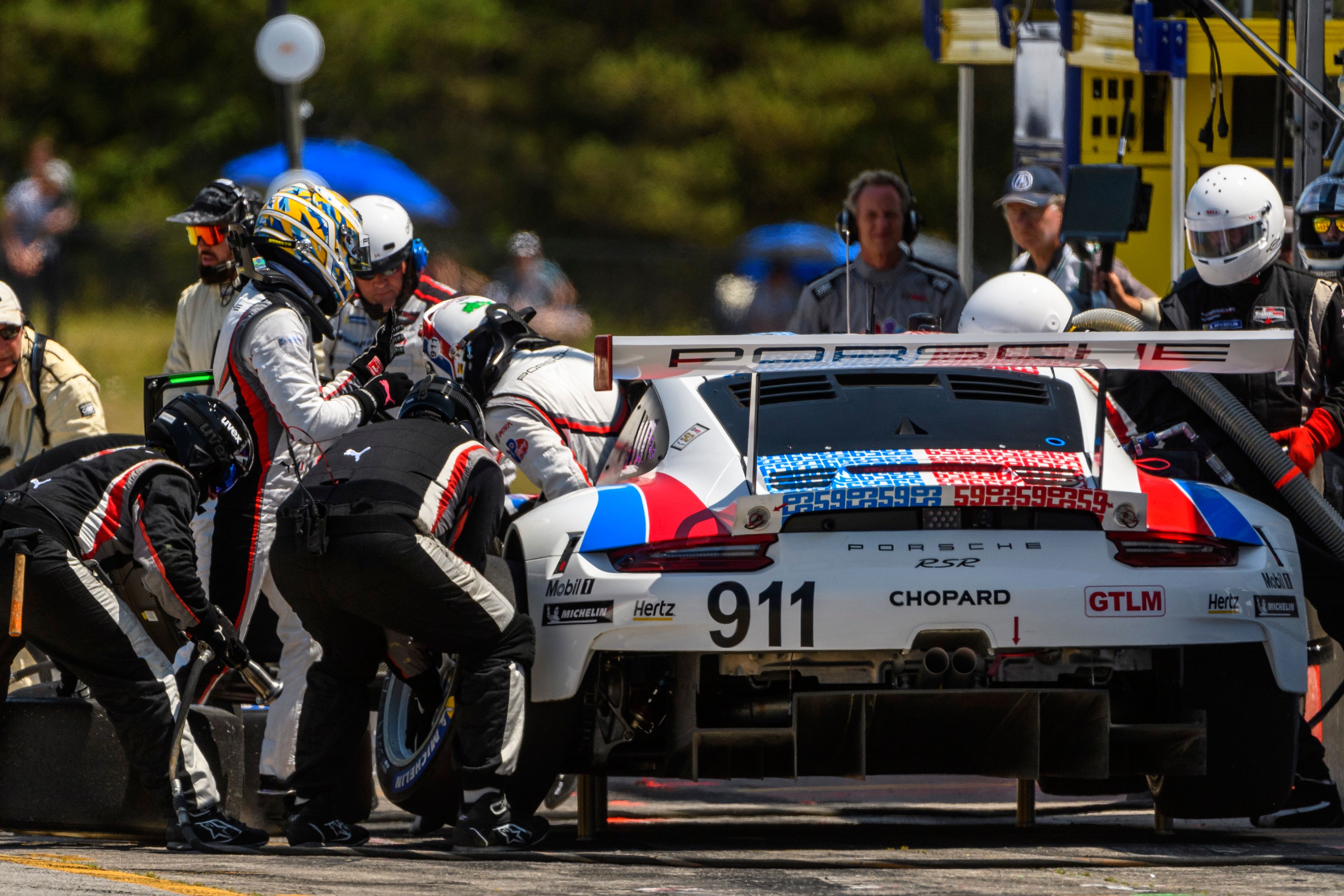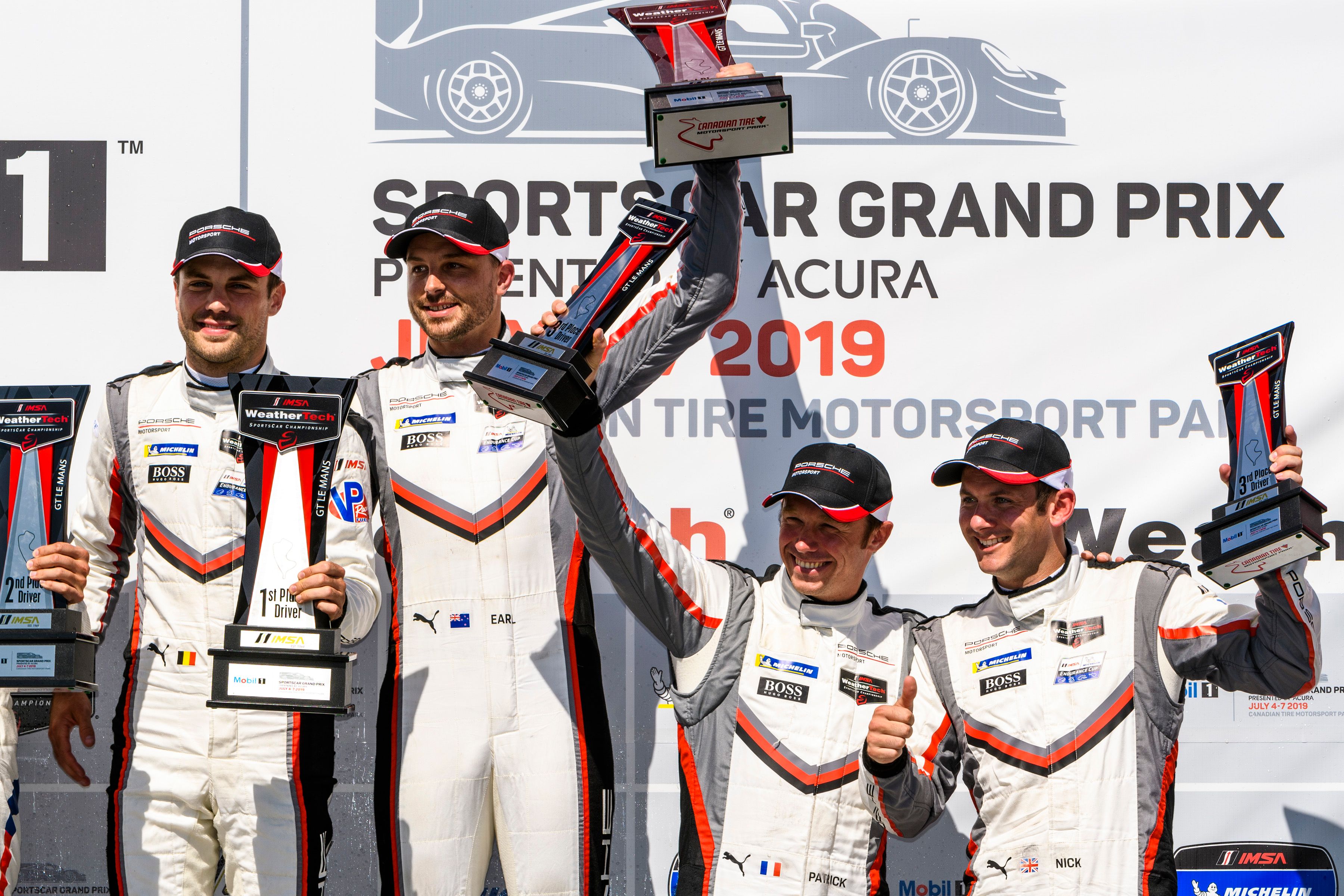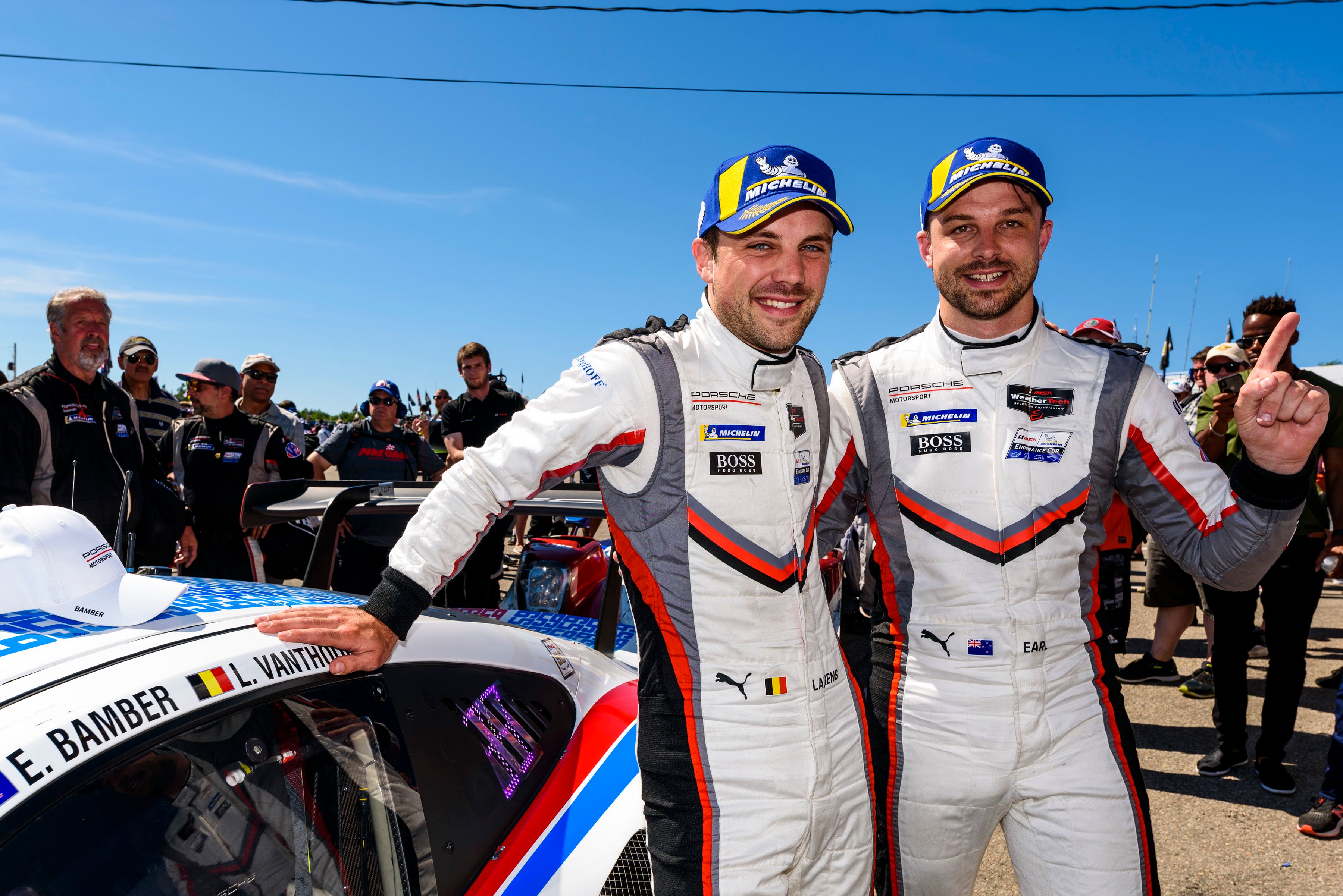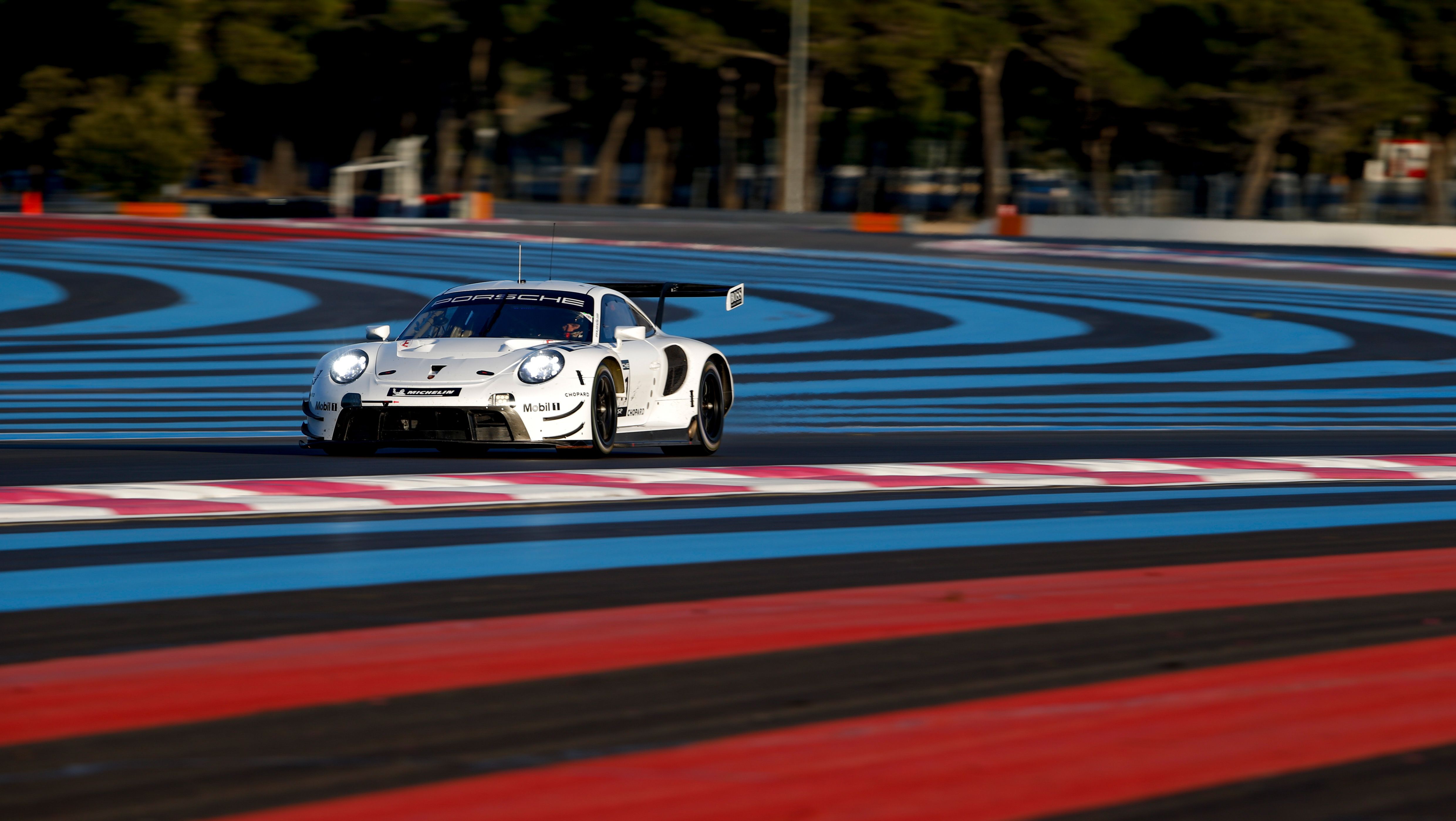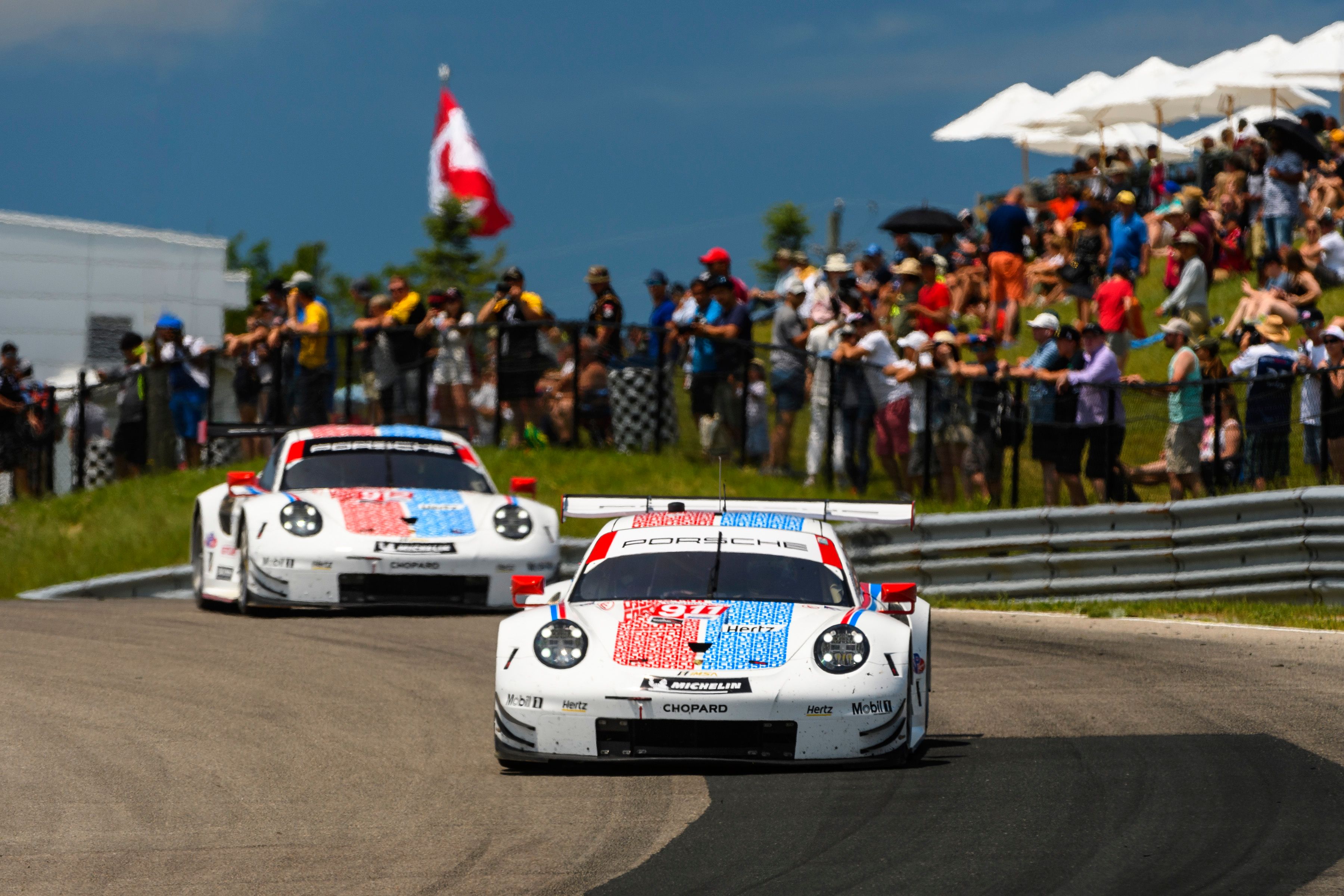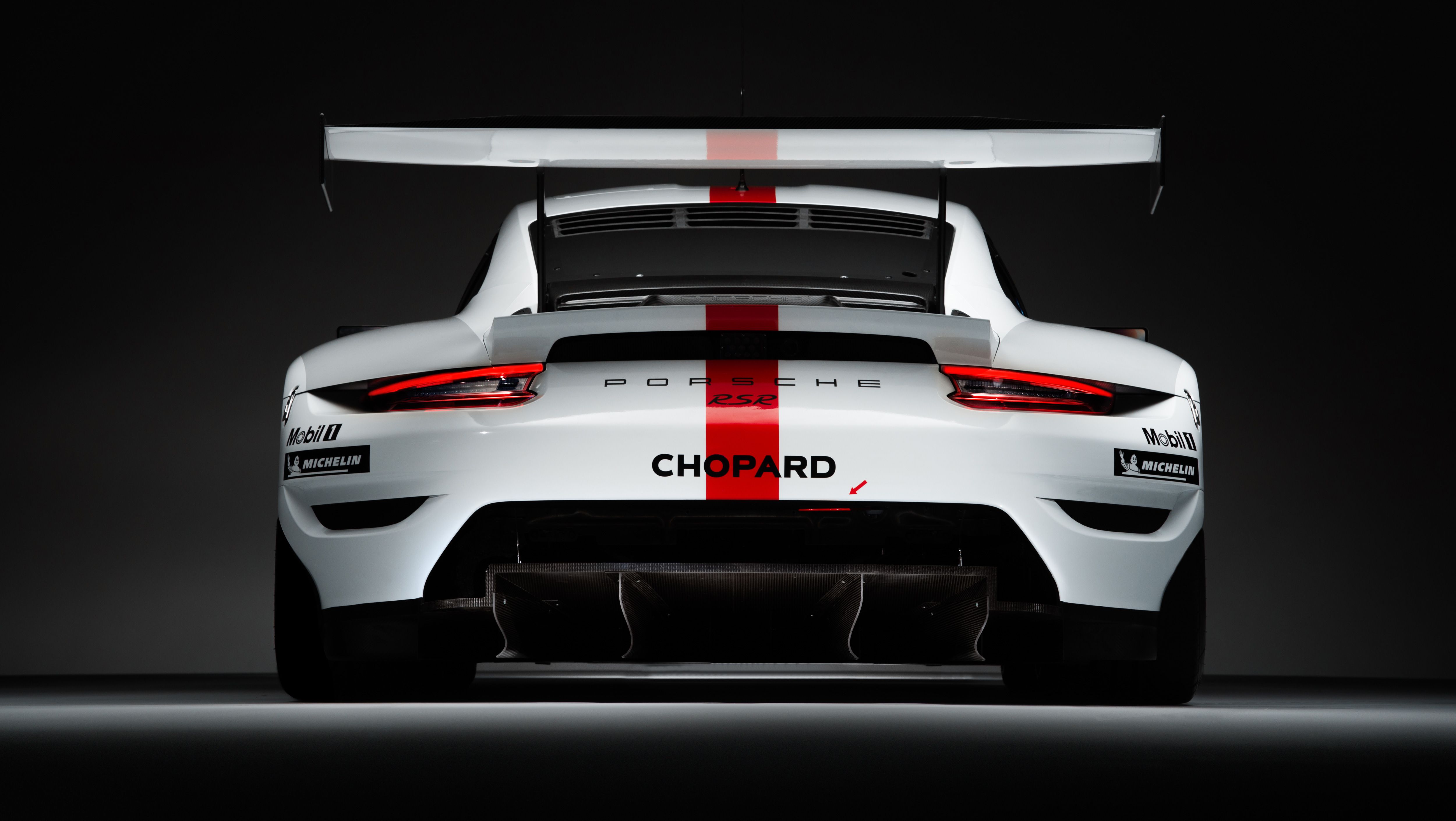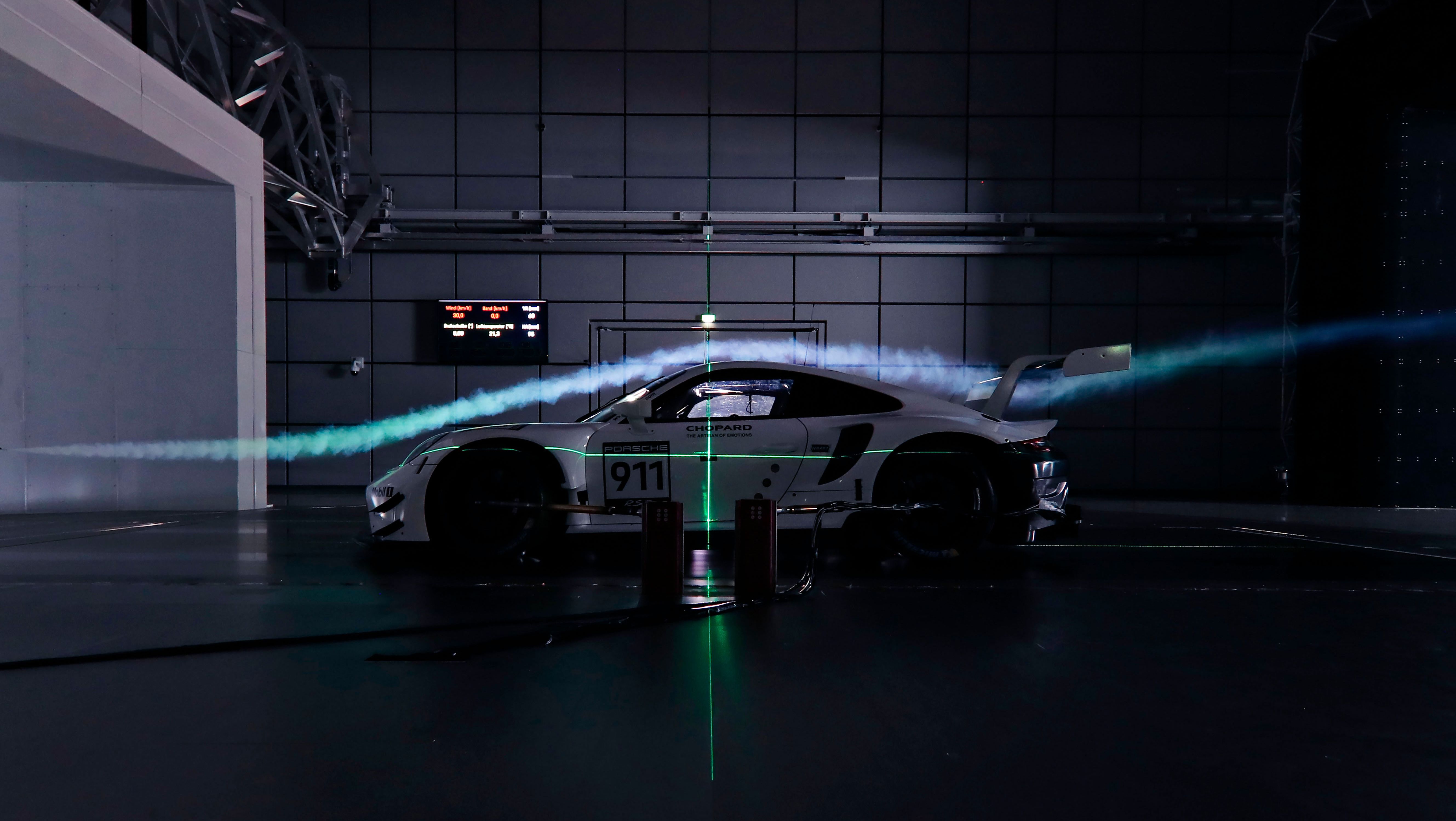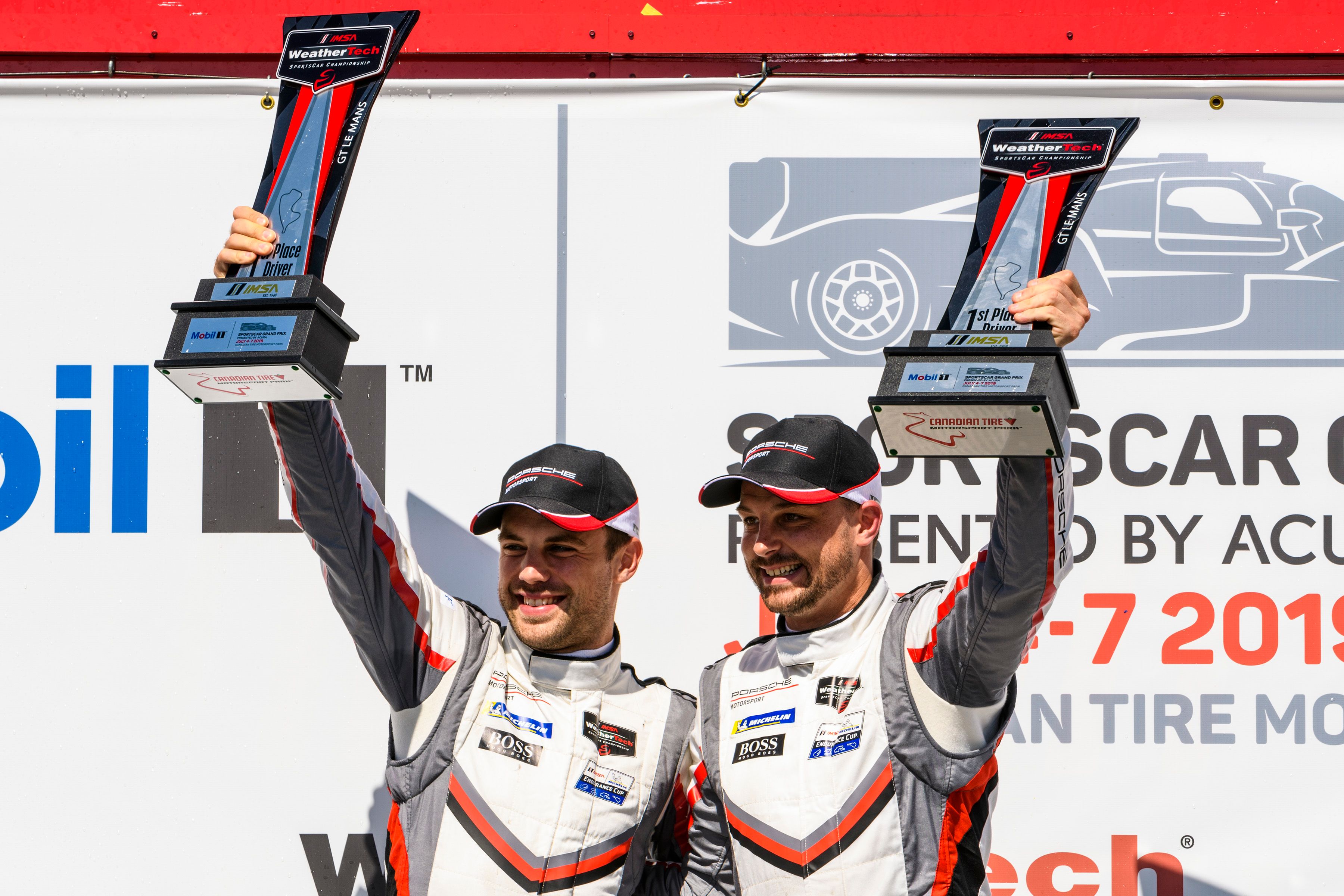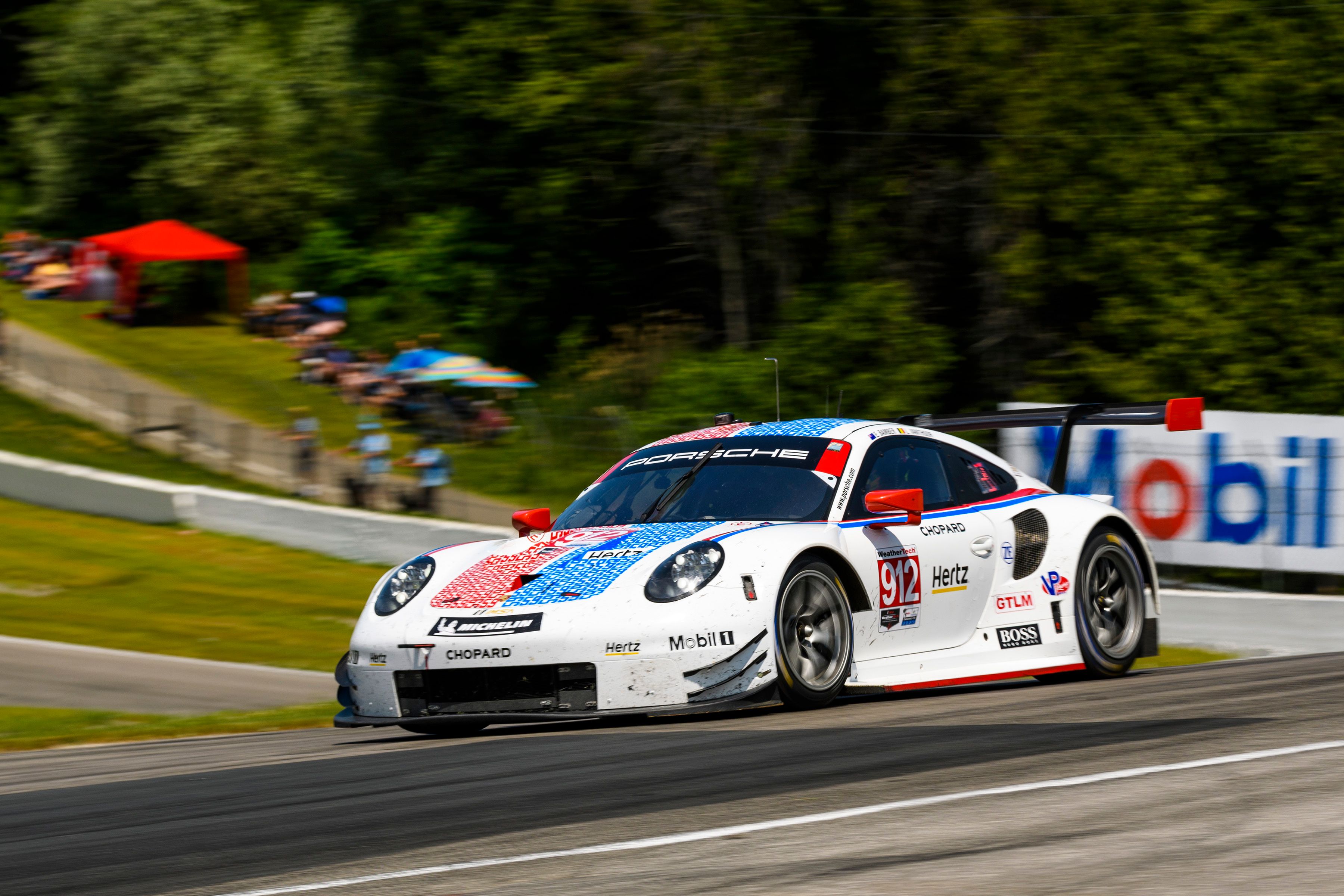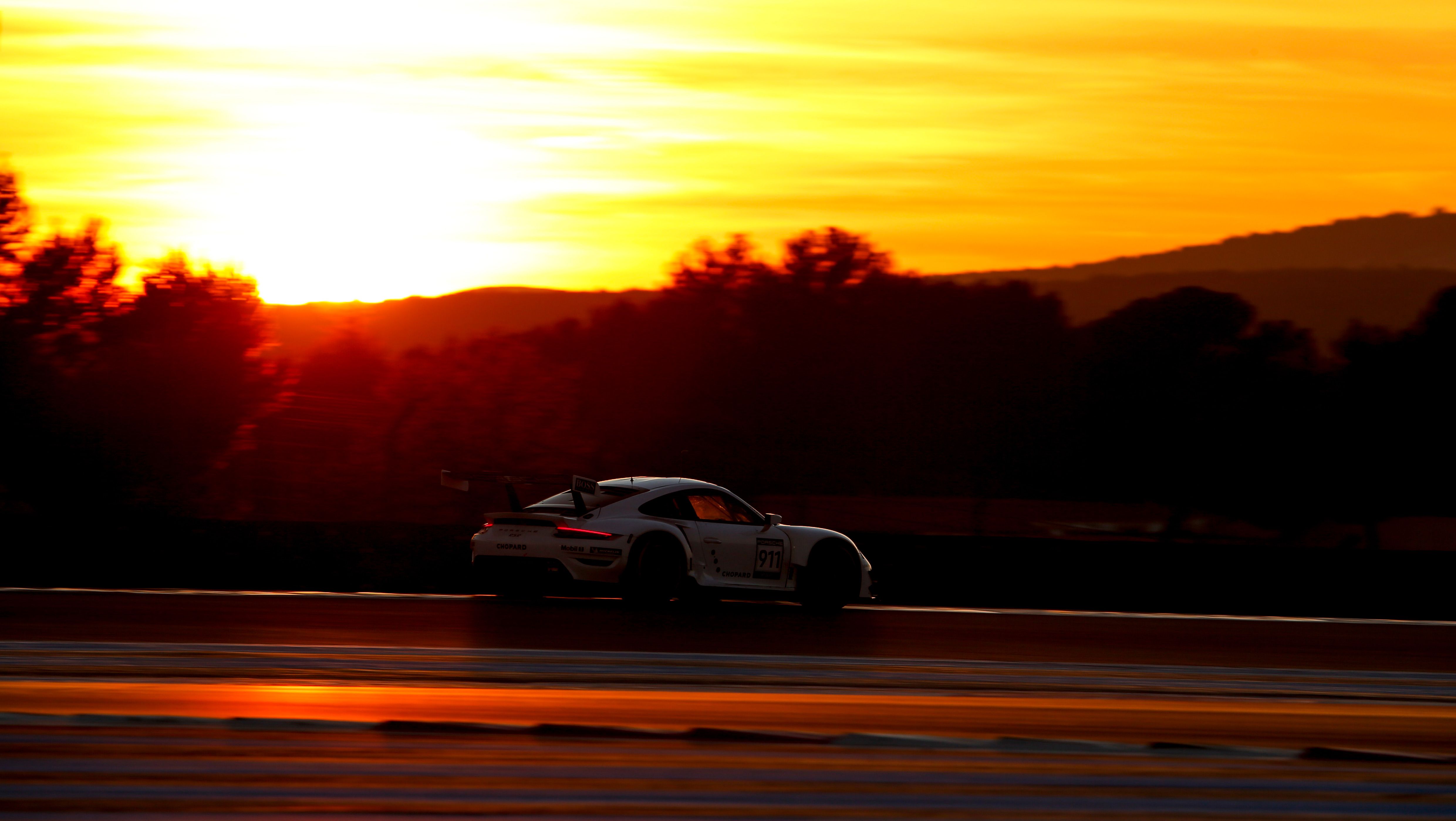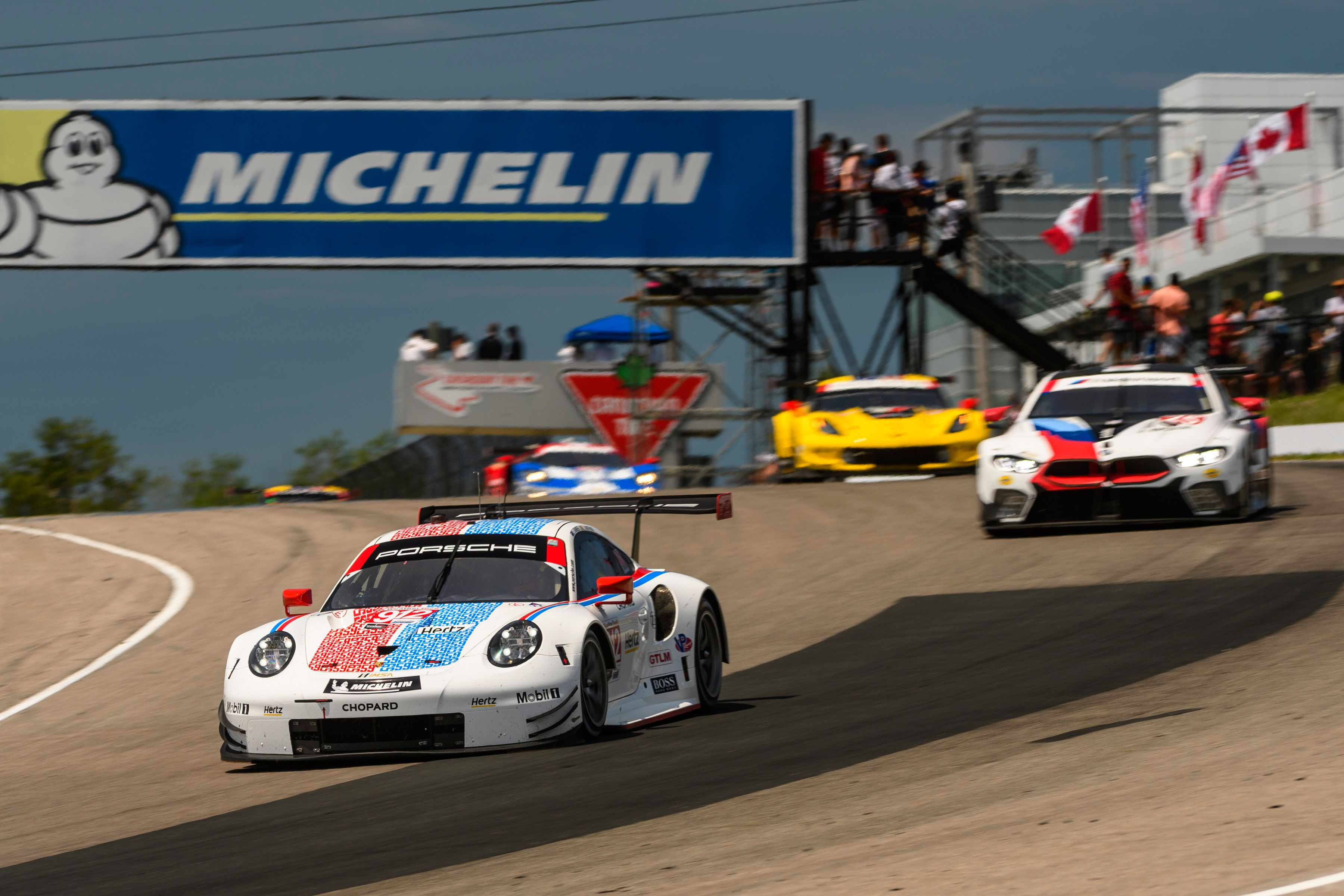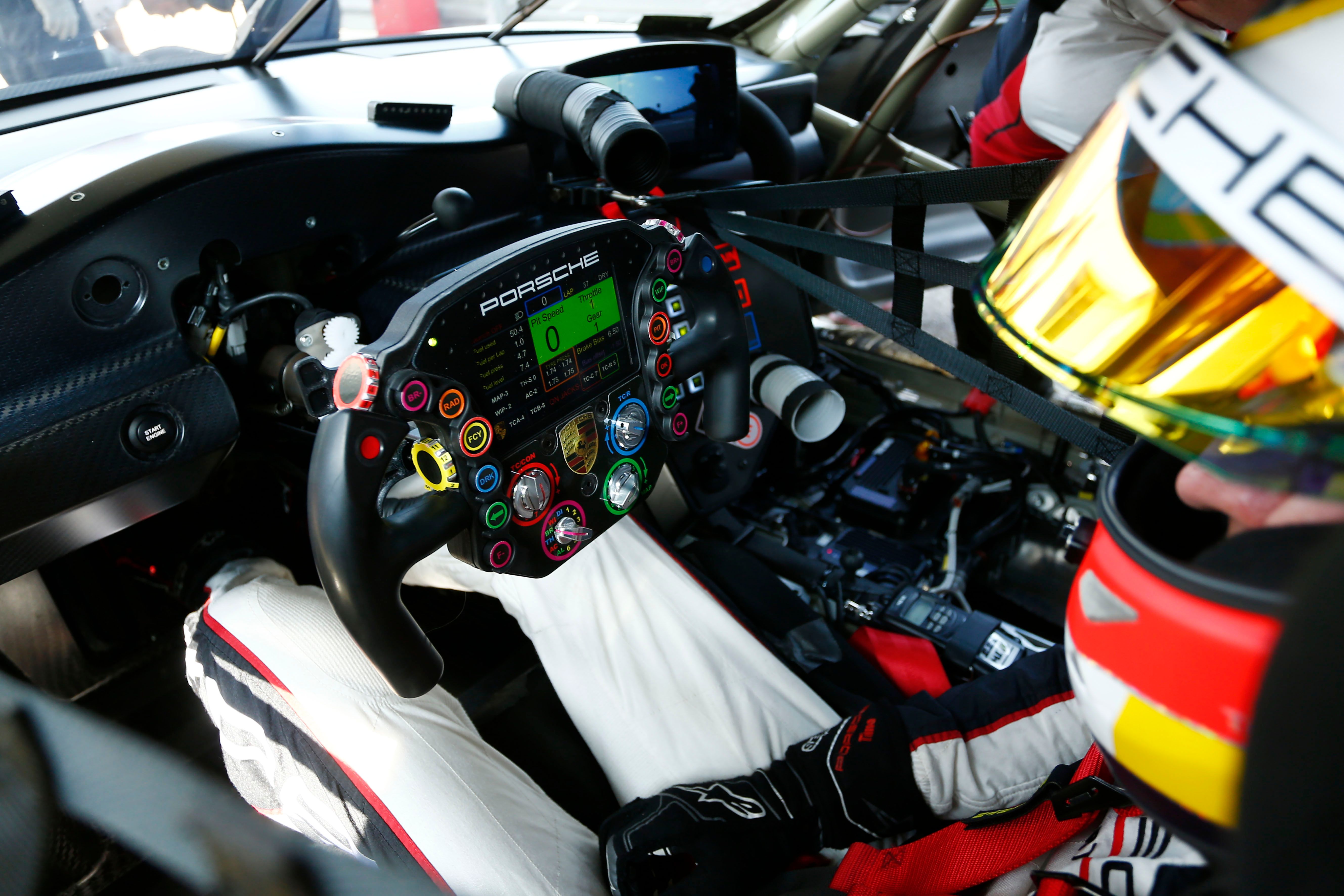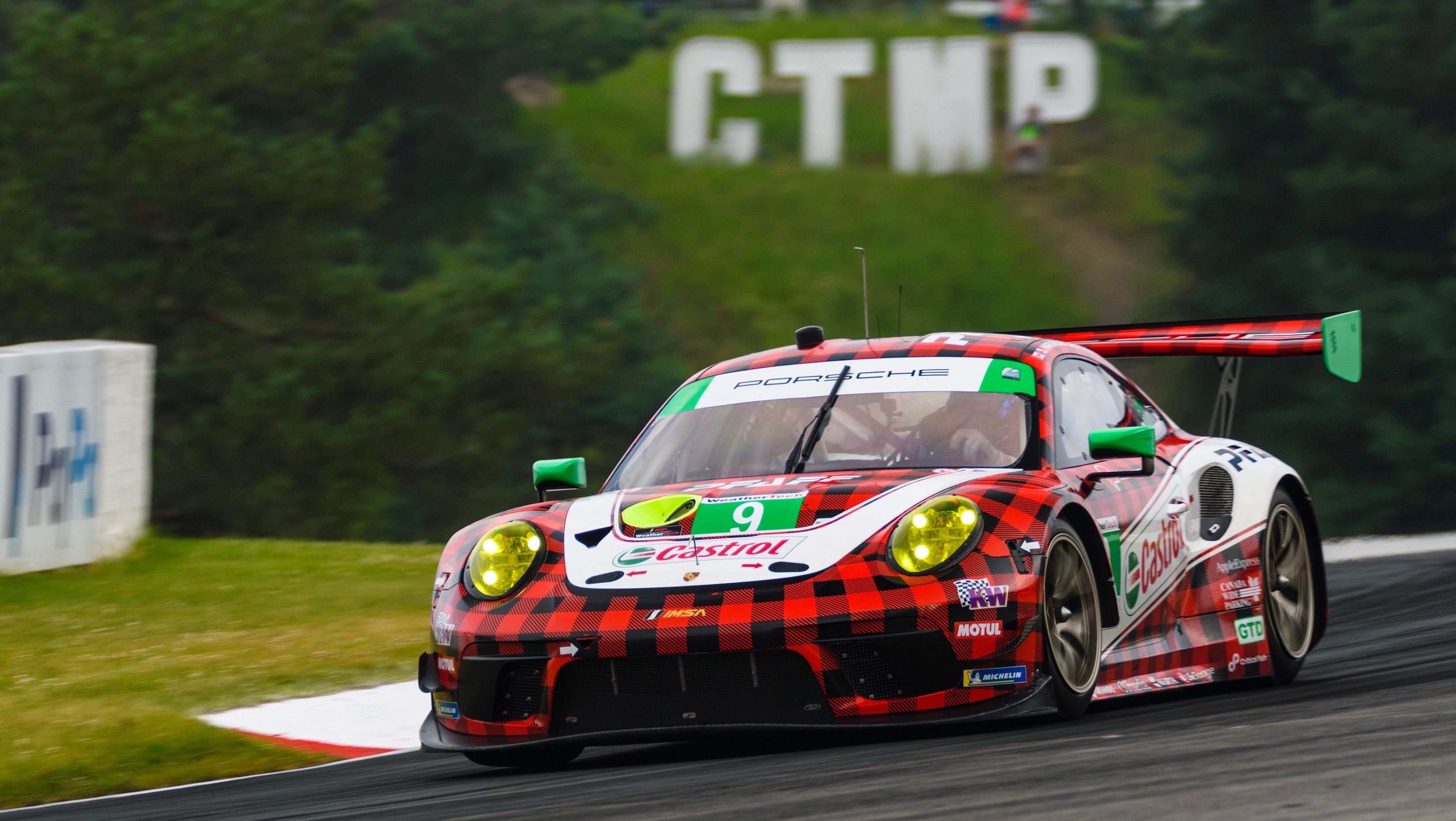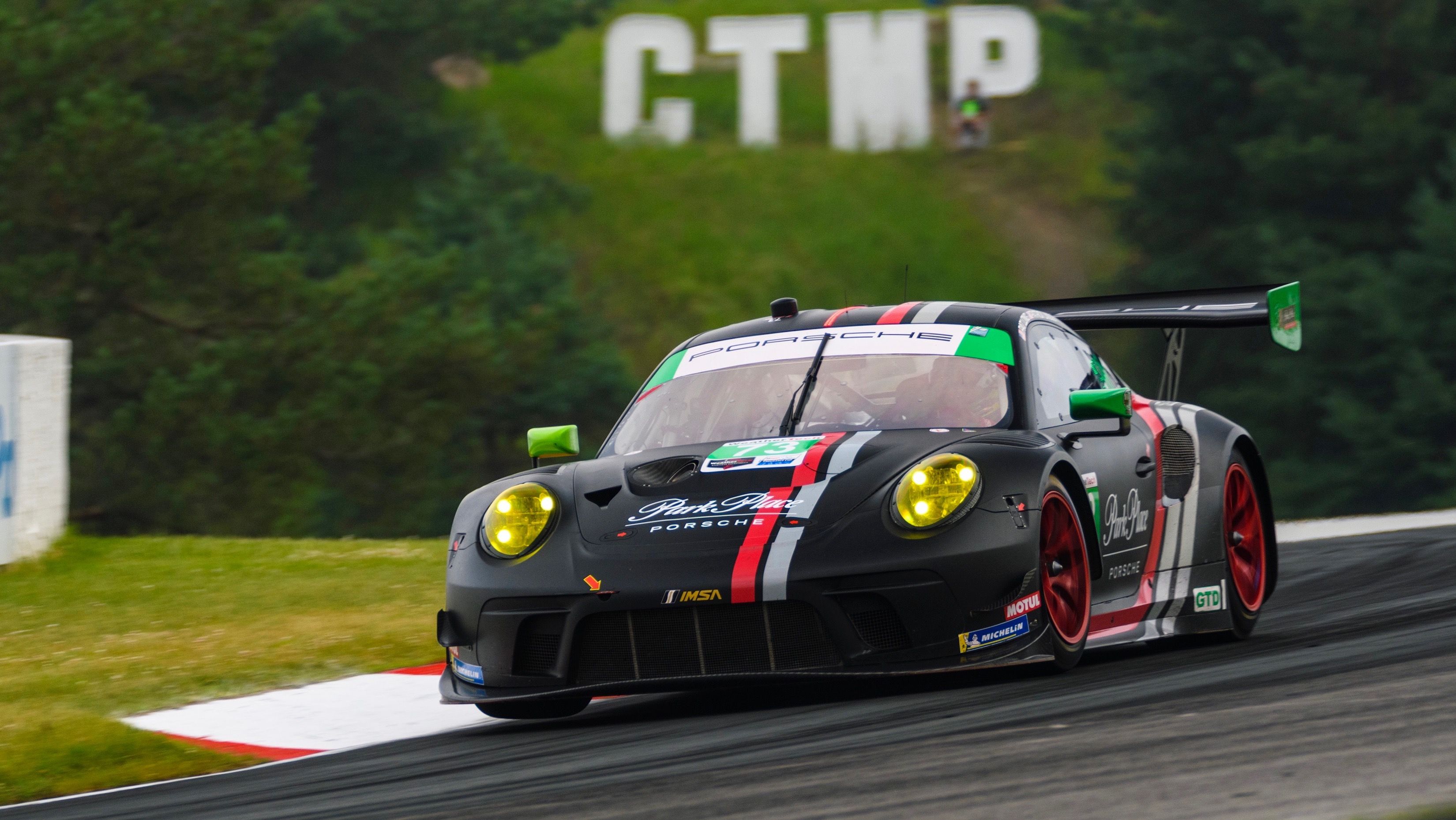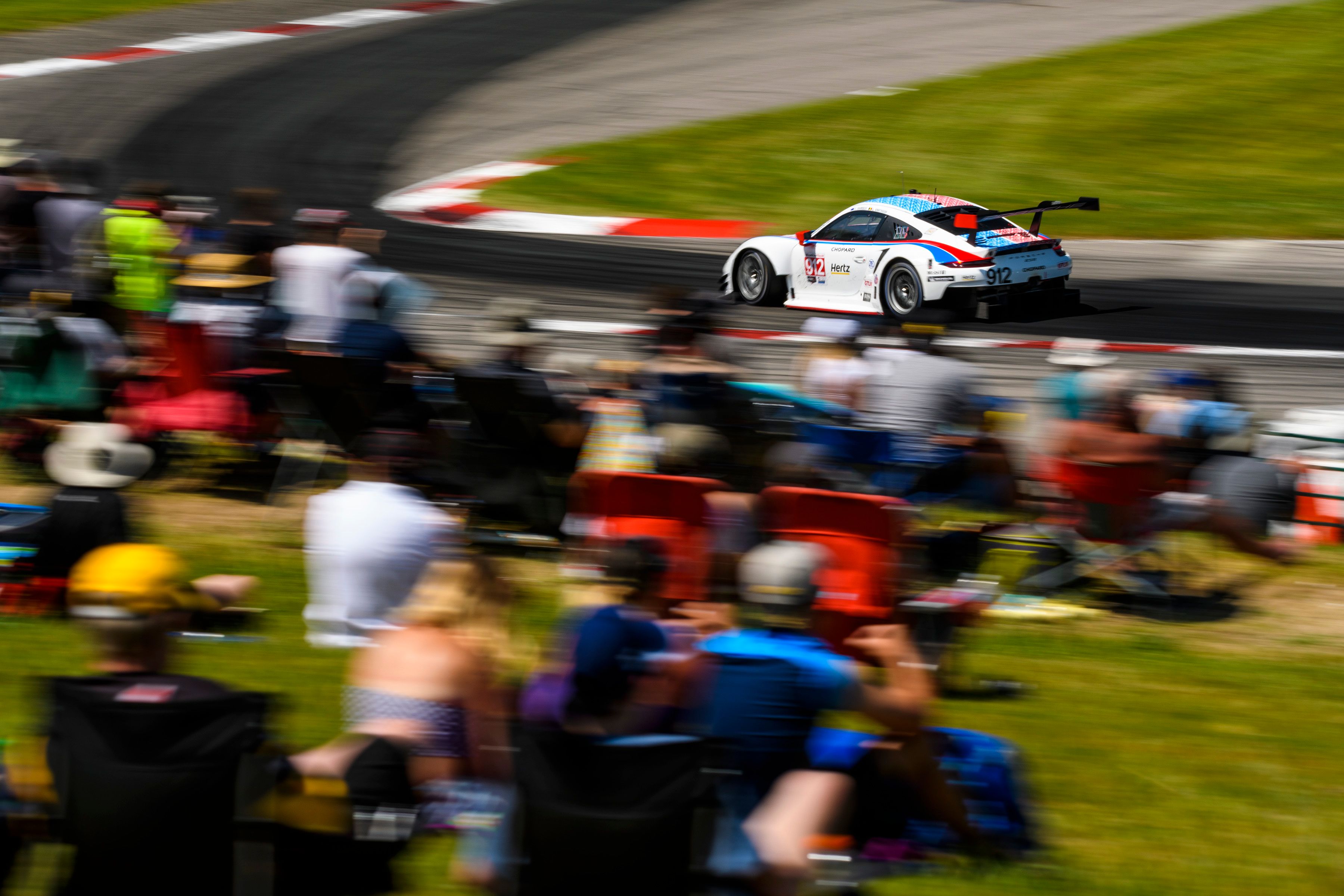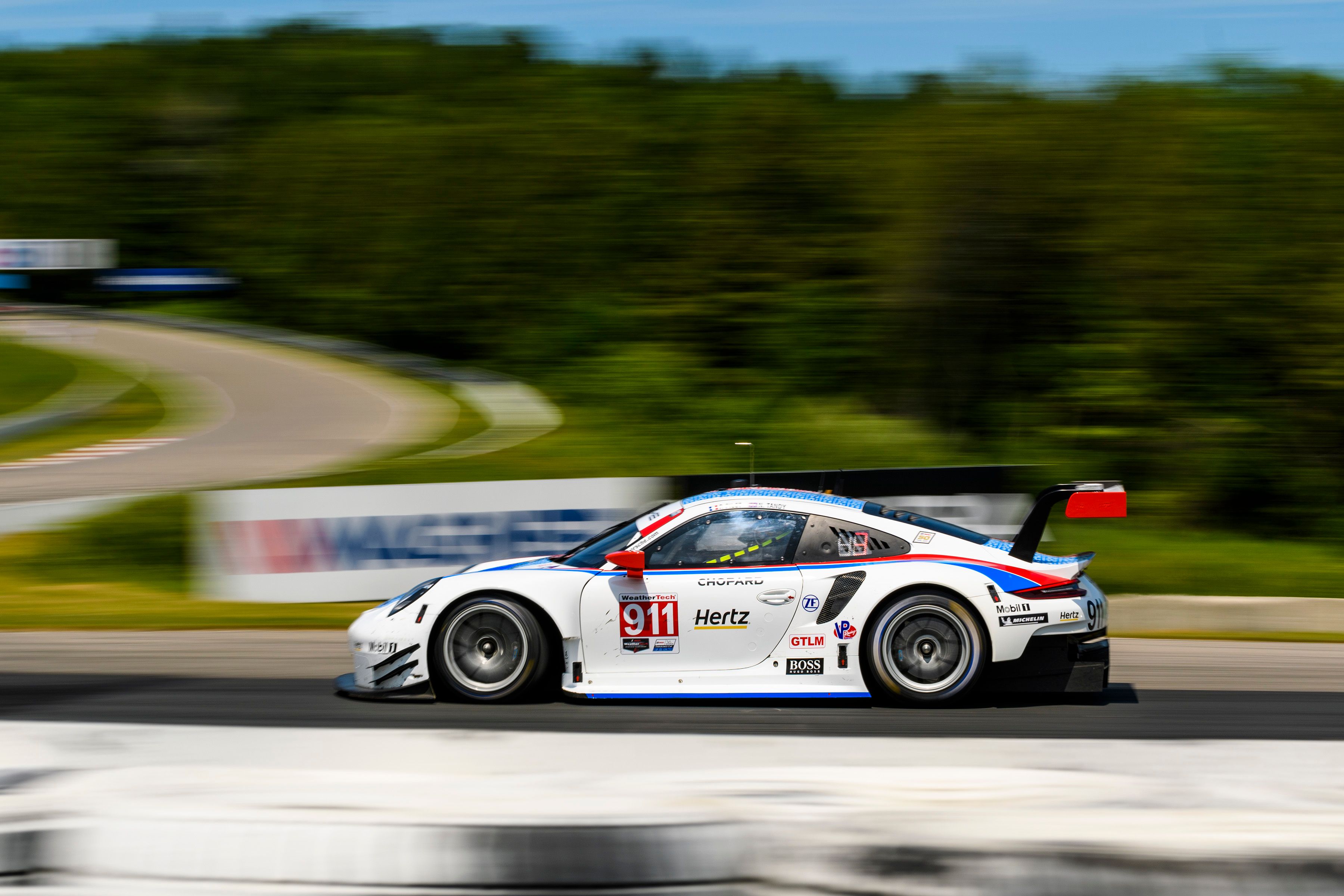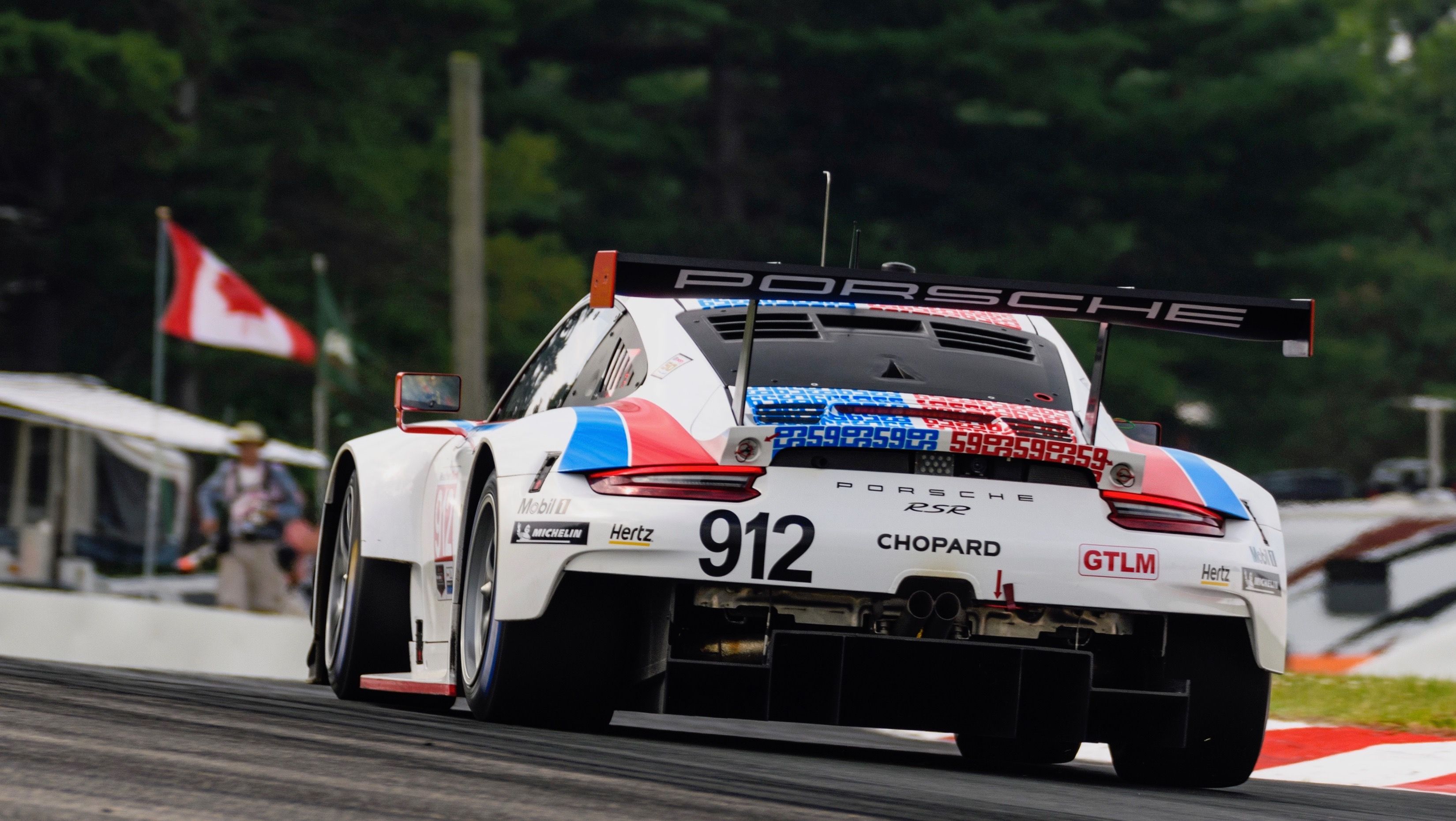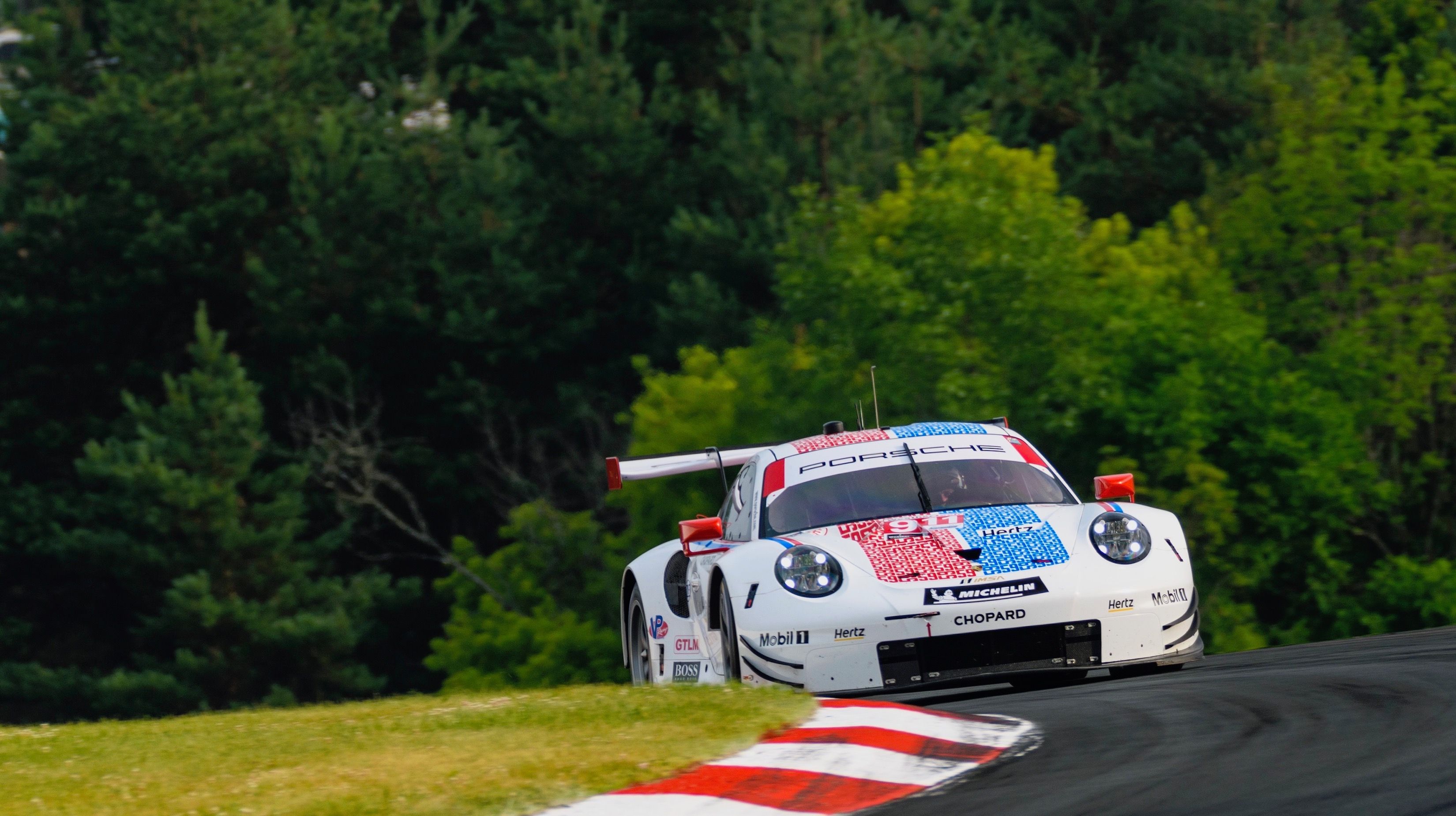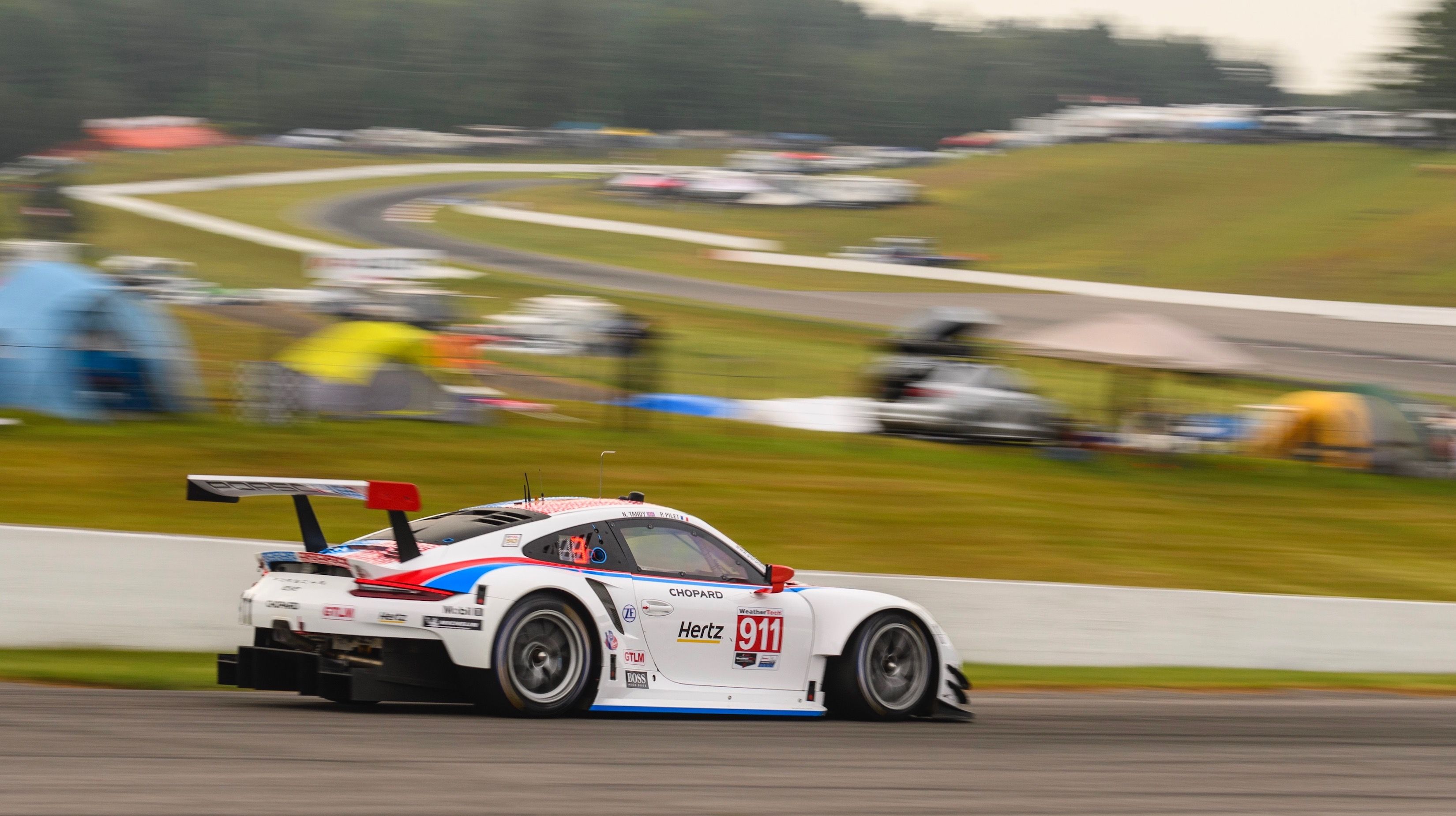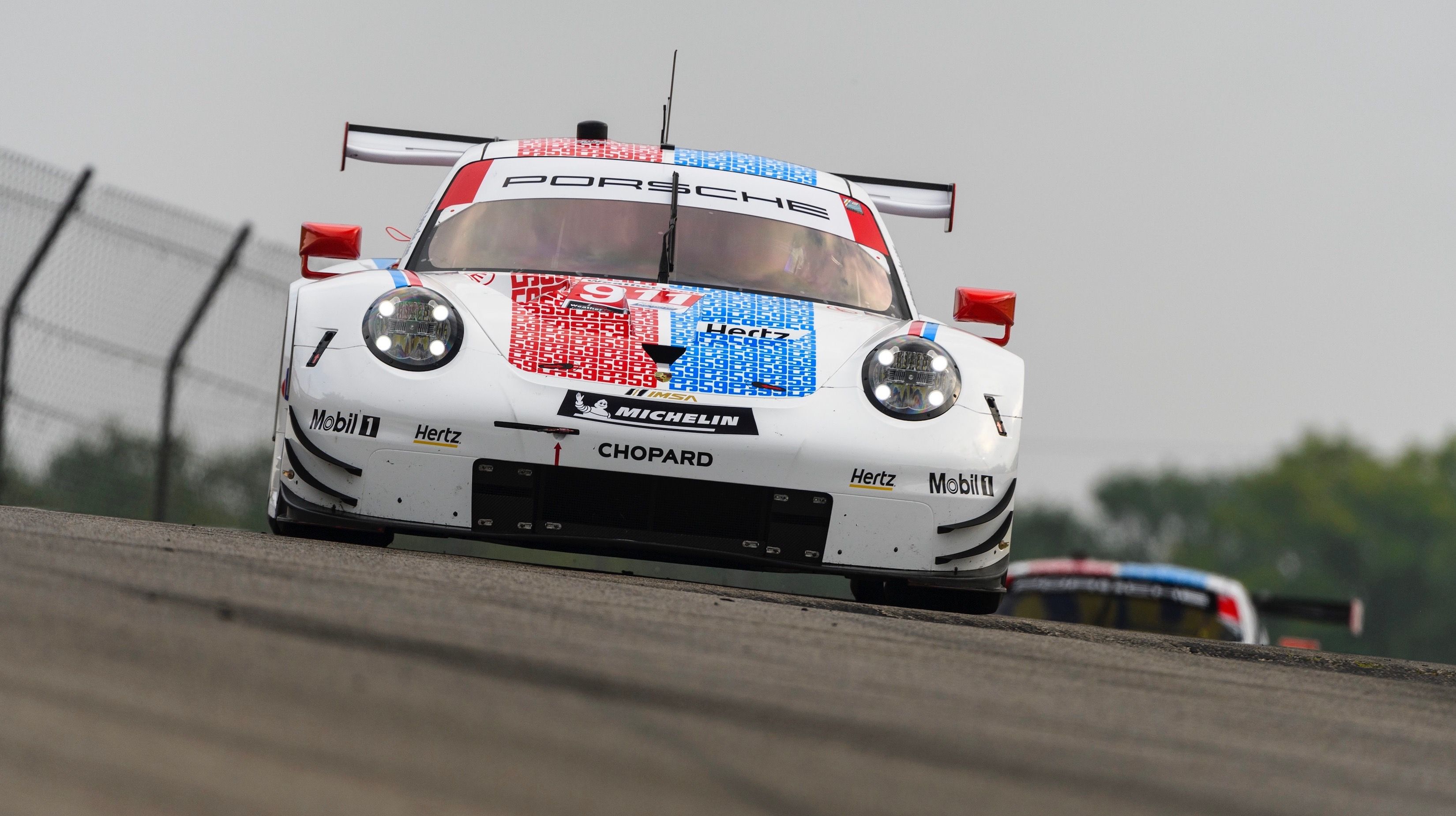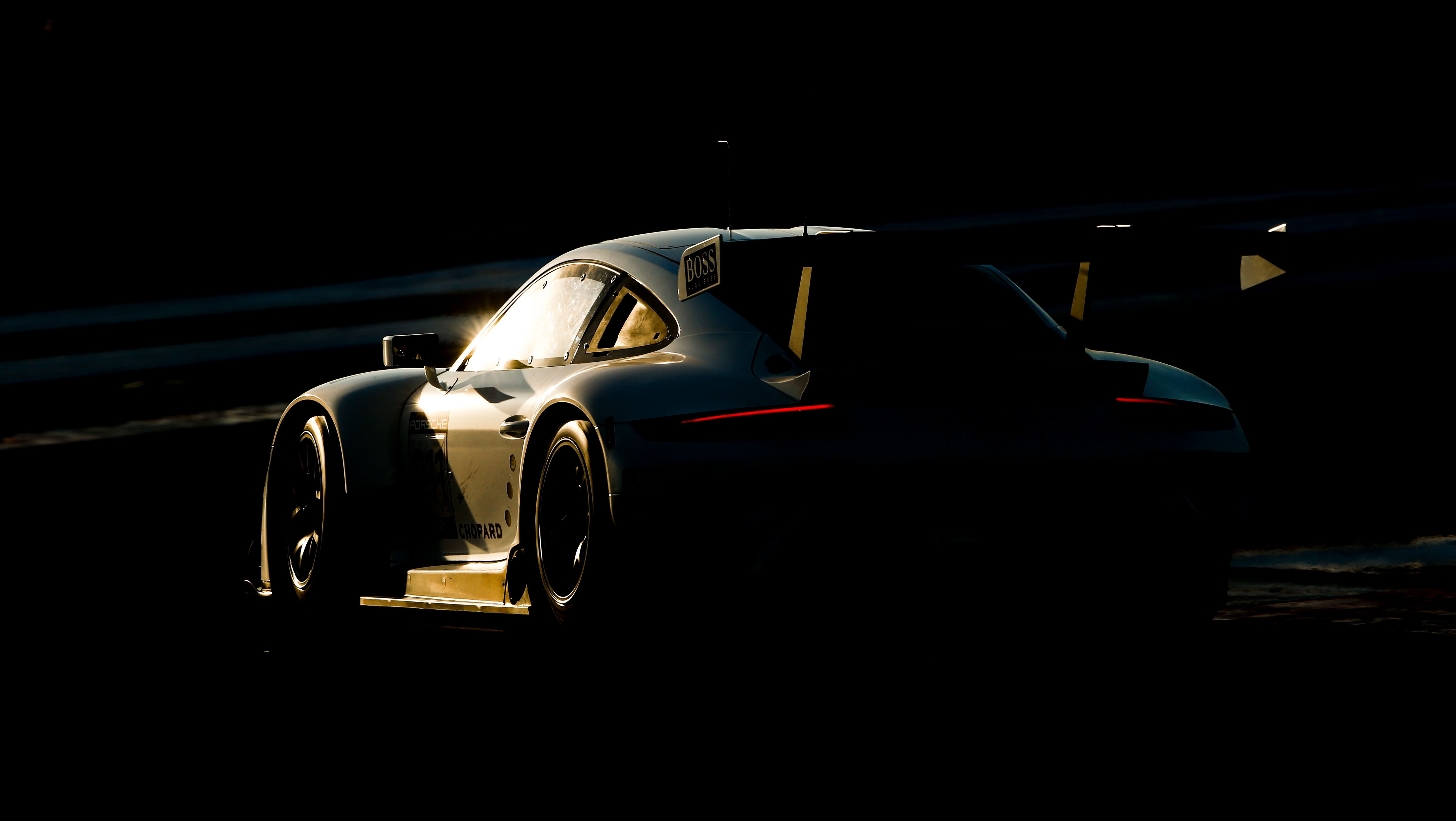Porsche unveiled at the 2019 Goodwood Festival of Speed the most expensive, most advanced, and fastest 911-based race car in its portfolio, the emblematic 911 GT3 RSR. This latest version takes everything good about the 2017 model and distills it all in a better overall package that's been improved in all four corners, even if you can't tell the differences from the outside. The engine is still naturally aspirated, but it's bigger than ever, and it's still placed in front of the rear axle. Power is said to surpass 500 horsepower depending on the restrictor, and it gets sent to the back wheels only, just as before. Now, however, the car is easier to service and is safer.
Porsche has been putting out 911-based race cars since the '60s and, in the five decades that have passed, the German automaker has constantly been improving the recipe while also staying true to the original ingredients. The shape is still largely familiar, albeit wider than ever, and the engine is still a six-cylinder boxer, and it's naturally aspirated. However, the differences are aplenty: the engine is now in front of the rear axle instead of behind it, the exhaust now exits in front of the rear wheels through the sills, it's water-cooled, and the capacity went up from 4.0-liters to 4.2-liters to make it more elastic. Is this the best 911 GT3 RSR ever? It has to be if it wants to surpass the impressive 2017 model that's won almost anything there is to win in the FIA WEC and the IMSA Weathertech Sportscar Championship. And, frankly, with a $1 million + price tag, it better be!
2019 Porsche 911 RSR
- Make: Array
- Model: 2019 Porsche 911 RSR
- Engine/Motor: flat-6
- Horsepower: 515
- [do not use] Vehicle Model: Array
Exterior
It's been 23 years since Porsche angered the establishment immeasurably by bringing to the 1996 24 Hours of Le Mans a car that respected the letter of the rulebook but not the spirit those rules. The car was the Porsche 911 GT1, a purpose-built GT racer made to resemble the 993-generation 911, but that featured a midship layout and extended front and rear overhangs for better downforce and air management. The pair of works-entered 911s humiliated the winner from the year before, McLaren's F1 GTR, and out-qualified the quickest BMW-powered F1 by 1.1 seconds while other examples were a whopping eight seconds adrift.
With everyone realizing that they'd be playing second fiddle if Porsche was to bring the 911 GT1 in the BPR Global GT Championship, the world's most important endurance series for grand touring cars, a line had to be crossed: Porsche would be allowed to race, but the 911 GT1 wouldn't score points, so everyone would end up fighting for second place. As it happened, the car never broke down in the three BPR races it competed in that year and, as a result, it won all three of them with ease, lapping the whole field at least once.
What happened after that is that the FIA took interest in the BPR Global GT Championship and picked it up, gave it the FIA's sticker of approval, and transformed it into the FIA GT Championship. Also, it was decided that everyone in the GT1 class was allowed to follow Porsche's path of building a race car then converting at least one example for road application to meet homologation requirements. Most of Porsche's key rivals from 1996 did just that: Lotus turned up with a Hydro-built Elise GT1, Lister prepped its own G-Force-built Storm GTL, McLaren lengthened the GTR as much as possible, Nissan came up with a whole new car named the R390 that loosely resembled the 300 ZX while Mercedes-Benz and Panoz joined the series for the first time with new, purpose-built cars: one, a mid-engined marvel that ended up dominating the whole season and the other, a front-engined mad child of Don Panoz and David Price that was lackluster in its first year but turned out to be competitive in 1998.
The key to the GT1's success was, besides its overstudied aerodynamics, the usage of a twin-turbocharged engine and, in 1997, FIA looked to annihilate the advantage of turbocharged cars as most of the other manufacturers ran naturally aspirated units.
In 2017, Porsche returned to the tracks for the very first time with a 911-badged race car that featured a rear mid-engine layout. The moniker was retained, but the second of the 991-based 911 GT3 RSRs was very different from all of the other RSRs that came before it. Porsche exploited a bit of a loophole in the rulebook that allowed manufacturers to move the engine around within the designated engine compartment of the road-going version. As Porsche's road-going car to which the RSR is (and was) based is the Porsche 911 GT3 RS, the Germans argued that the space behind the seats was also part of the engine compartment since the street version's got no back seat and it's just an empty area there filled by the roll cage essentially. That's how the engineers managed to move the engine in front of the rear axle and thus free up a lot of room underneath the car for a proper diffuser with elongated venturi tunnels and, also, helped them play with the balance of the masses better.
Why I'm saying this is a loophole? Well, Porsche said after introducing the 2017 Porsche 911 GT3 RSR that a mid-engined 911 for the road isn't part of Porsche's plans in the future so, in essence, Porsche's running a car that it's not able to sell to its customers right now - the same way Ford ran for a full season with the Ford GT GTE race car while customers were still waiting on the road car. BMW also raced something it never offered in showrooms back when the Z4 was Munich's weapon of choice in both GT3 and GTE-level competition.
So, let's go back to the 2019 Porsche 911 GT3 RSR. From the getgo, Porsche had a tough job improving what is one of the best GTE-spec cars out there. Granted, BoP's got a lot to do with how much success a GT racing car can achieve in its career, but it's also important to remember that to finish first, first you must finish. In other words, even if, for instance, Porsche's BoP at the 2018 Le Mans 24 Hours when the pair of retro-looking 911s dominated the race (the Pink Pig-esque car won by two minutes over the Rothmans-style one) was on its side, the cars still had to finish to gather all the laurels of victory. In any case, the 2017 model has won some 20 international races over the course of three seasons (and the 2019 season isn't even over), and it's currently the car to beat in IMSA's Weathertech Sportscar Championship when the pair of CORE Autosport-prepped 911s have won the last five races in a row.
|
|
ids=848875,848876 |
no_overlay=false |
before_label=2019 Porsche 911 RSR |
after_label=2019 Porsche 911> |
In the front, the 2019 Porsche 911 GT3 RSR sports a redesigned inlet setup. On the old car, there was only one inlet with the sides of the lower front fascia devoided of other openings. The new version still features only one main opening but, this time around, the 'mouth' is divided into three as there are now two other inlets placed on either side of the main one, with curved upper corners. The lip of the splitter has been redesigned, and it now curves upwards in the middle of the front end while the tips (towards the leading edge) sweep up as well to better direct air around the front overhangs.
At Le Mans, the 911 GT3 RSR will run without the four winglets that can be added to the corners of the front bumper for when you need the nose to be extra planted on more technical tracks where top-end speed isn't critical. From the side, you'll notice that the fender flares actually don't extend all the way down to the rocker panels. The body retracts a few inches away from the side skirts aft of the front wheels, something you'll notice around the back where the rear bumper suddenly narrows down towards its lower extremity on either side for better airflow around the tires.
From the back, the 911 GT3 RSR looks menacing. For starters, it lacks a rear window because that's where the engine is placed and Porsche has yet to morph into Ferrari and feel the need to show off the midship engine on any model it makes (you get that to some degree with the Carrera GT and the 918 Hybrid, though). There are nine slats towards the top part of where the rear window should be located, and there are others down below at the border between the would-be window area and the bodywork - these vents are part of a carbon fiber element with Porsche written in the middle.
The lower bumper is adorned by two narrow vents and the massive diffuser with an opening above it. The diffuser (that features four curved elements) is bigger than ever before because the exhaust pipes no longer exit through the space above it, Porsche redesigning the piping so as to make'em exit through the rocker panels just before the rear wheels. This means the exhaust system is lighter and shorter, aiding performance.
Porsche has been running the past few seasons in the same livery it debuted in 2017 that was also shared with the LMP1 cars that have since been retired. For the 2019-2020 FIA WEC season, however, Porsche brings a new livery. The cars will run in the color combination seen at the 2019 Goodwood Festival of Speed where the car made its worldwide debut. According to dailysportscar.com, the " No. 91 911 RSR-19 will be predominantly white, with a centrally-placed red stripe extending from the front hood over the roof to the rear apron, as well as red side sills with grey highlights on the side."
As an American, your first chance to see the car in the flesh will be at next year's Roar Before the Daytona 24 Hours while its North American racing debut will take place at the 2020 Daytona 24 Hours. Porsche Motorsport North America will again field two CORE Autosport-prepped cars in 2020.
2019 Porsche 911 RSR exterior dimensions
|
Length |
180.82 inches (without splitter, rear wing, diffuser) |
|---|---|
|
Width |
80.39 inches (front axle) / 80.70 inches (rear axle) |
|
Wheelbase |
98.93 inches |
Interior
The cabin of the 2019 Porsche 911 GT3 RSR is akin to that of a spacecraft, one optimized for quick driver changes and user-friendliness. Once you hop in the driver's seat, by jumping over the bars of the roll cage, you find yourself in front of a multi-functional steering wheel and a center console covered in back-lit buttons and knobs. Everything has been organized following the input from various Porsche works drivers as well as customers that provided their opinions on what can be improved in the cockpit.
Porsche drivers will also benefit from the latest generation of Wiessach's clever collision warning system that displays on the screen what cars are around you, similar to the way parking sensors yell at you and show you how close you are to the car in front and the one behind. These systems have been around for a few years (Corvette Racing was among the first to fit a screen with active safety features incorporated back in 2014 when it introduced the Pratt & Miller-built C7.R), but Porsche's latest iteration promises to be one of the best out there.
As mentioned, there are more switches on the center console, but a few are of vital importance: the main kill switch of the electrical system, the ignition knob (just below it and just above the Start button), and the buttons for the fuel cutoff and the in-car fire extinguishing system. Hoses that sprout from next to the wheel and the dash ventilate the interior (car comes with A/C).
Drivetrain
Just 515 horsepower, that's how much the Porsche 911 GT3 RSR makes (depending on the size of the air restrictor, of course). To put it in perspective, your average GT3-spec car puts out between 450 and 500 horsepower and GT4 cars are leveled at around 400 horsepower. The road-going Porsche 911 GT3 RS (991-derived) puts out 513 horsepower from its 4.0-liter, naturally aspirated flat-six and 347 pound-feet of torque. The 992-generation 911 GT3 will probably go turbo and, as such, the 4.0-liter unit might be retired.
However, Porsche doesn't plan to go with turbocharging for its 911 GT3 RSR racing version (the Ferrari 488 GTE and the BMW M8 GTE are turbocharged, for example) and, as a result, you can bask in the awesomeness of the new 4.2-liter flat-six, the biggest ever fitted to a 911. We don't yet know how much torque the engine develops, but it must be at least 400 pound-feet.
All of the power is sent to the rear wheels through a (quicker than before) six-speed, sequential, constant-mesh gearbox with a multi-disc, self-locking differential. Of course, flappy paddles behind the wheel control the madness. Suspension is by double wishbone all around with four-way vibration dampers, coil springs, and anti-roll bars. The rear suspension is part of a subframe, and the setup is identical to that on the front axle. Steering is by rack-and-pinion with electro-hydraulic power steering.
The massive brakes that call the area behind the 18-inch forged alloy wheels home are served by two separate circuits, one for the front brakes and another for the rear brakes. Six-piston calipers with quick-release coupling grip to the 15.35-inch front discs while four-piston calipers are fitted to the 13.97-inch rear discs.
The change in the exhaust system means that the new GT3 RSR won't sound as menacing as the car it replaces but, as people who've attended the 2019 Goodwood FoS can attest, it still is a badass-sounding piece of kit that easily trumps both the BMW and the Ferrari in the sound department - and even Corvette, given that the C8.R's singing voice is now closer to the Ferrari's.
Road & Track reported, after driving the 2017 version, that "with weight concentrated more centrally, there’s less vertical motion, less of the traditional 911 squatting and diving in response to throttle and brake inputs and midturn bumps." The new car will only improve on that. In the same piece, the old RSR's braking stability (sans ABS) was also applauded, and the new car will be even more stable and planted on turn-in.
2019 Porsche 911 RSR exterior dimensions
|
Length |
180.82 inches (without splitter, rear wing, diffuser) |
|---|---|
|
Width |
80.39 inches (front axle) / 80.70 inches (rear axle) |
|
Wheelbase |
98.93 inches |
Pricing
If a road-going 2019 model year Porsche 911 GT3 RS will set you back about $187,500, the new 911 GT3 RSR will cost well over $1 million. The six customer cars built for the 2018 season were all sold for a price of $1.1 million apiece, so it's easy to guess that the new works cars are even more expensive (they'll also become available for customers in 2020).
If you can't afford to buy and then running and servicing the GTE-spec 911 GT3 RSR, Porsche offers you plenty of alternatives: there's the $514,607 GT3.R model and upwards of 550 horsepower and, lower down, the 718 Clubsport GT4 that starts at $151,000 in 'track day' trim. Of course, for the new-for-2020 GT2 class, Porsche's got at the read the GT2 RS Clubsport with an MSRP of $478,000. It's all down to your pocket!
Final Thoughts
"We never rest on our laurels," said Pascal Zurlinden, Porsche's Chief of the Factory GT Racing division. Indeed, the latest GT3 RSR looks to build on all the pro's of the 2017 model and minimize its shortcomings. This is a very hard job since we're talking about a car that has won the 24 Hours of Le Mans in 2018, the FIA WEC GT World Championship title and is romping away towards the IMSA GT Le Mans title this season. So, can you really improve a car that's already stellar? Porsche thinks so and the result of its thought process, the RSR-19 has to be astounding to beat its ultra-successful predecessor that's still got a few bullets in the barrel until the end of the year (in the factory's hands) and then another season in privateer hands.
Further reading
Read our full review on the 2017 Porsche 911 RSR.
Read our full review on the 2020 Porsche 911.
Read our full review on the 2020 Porsche 911 992 Cabriolet

